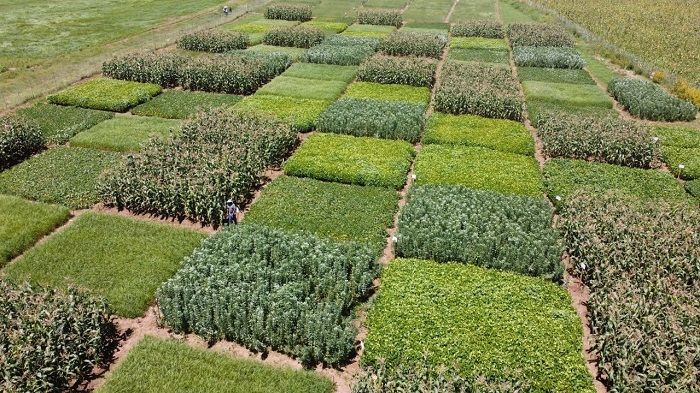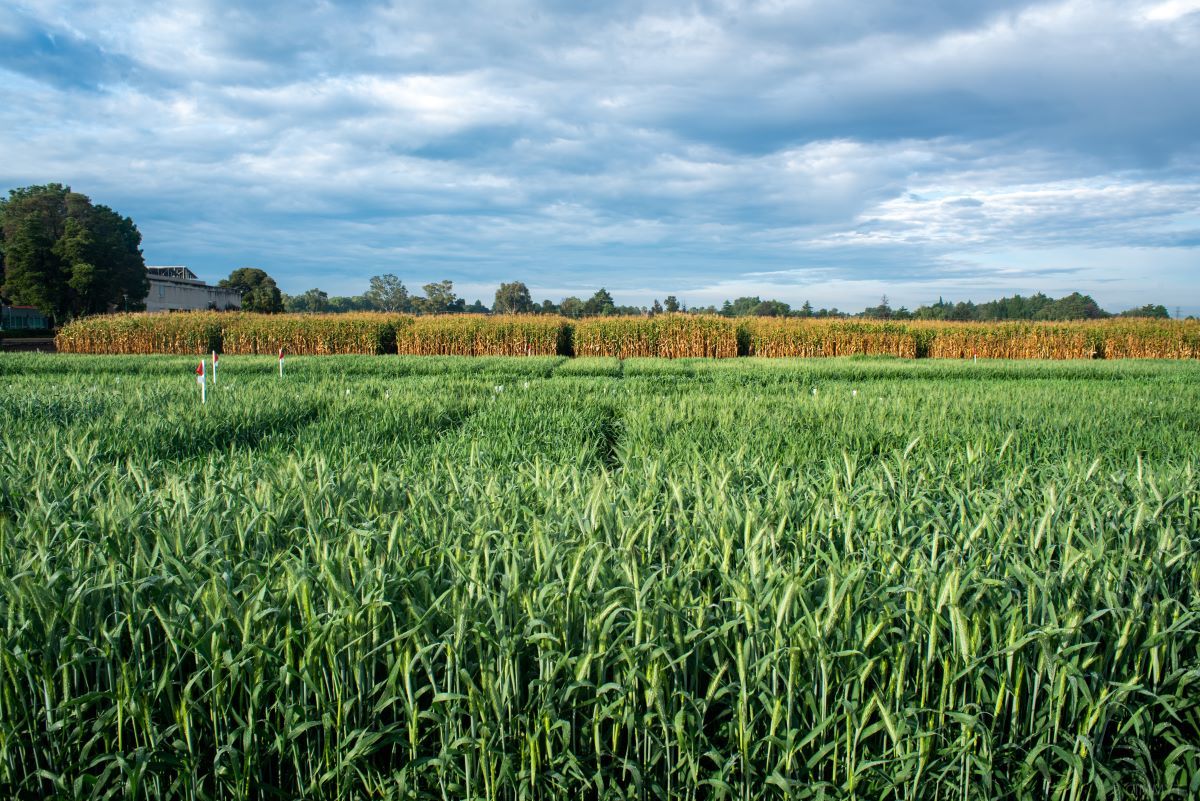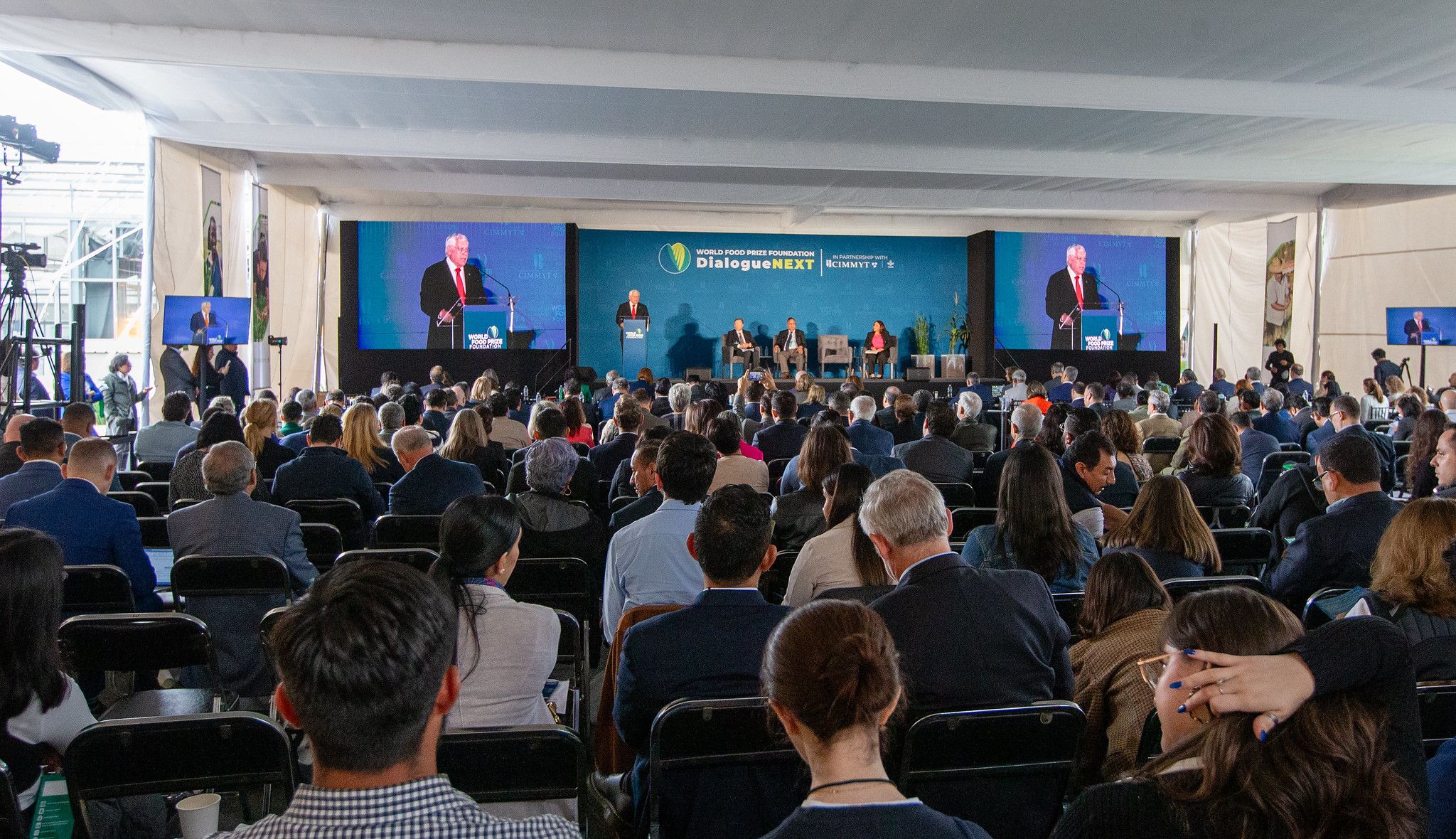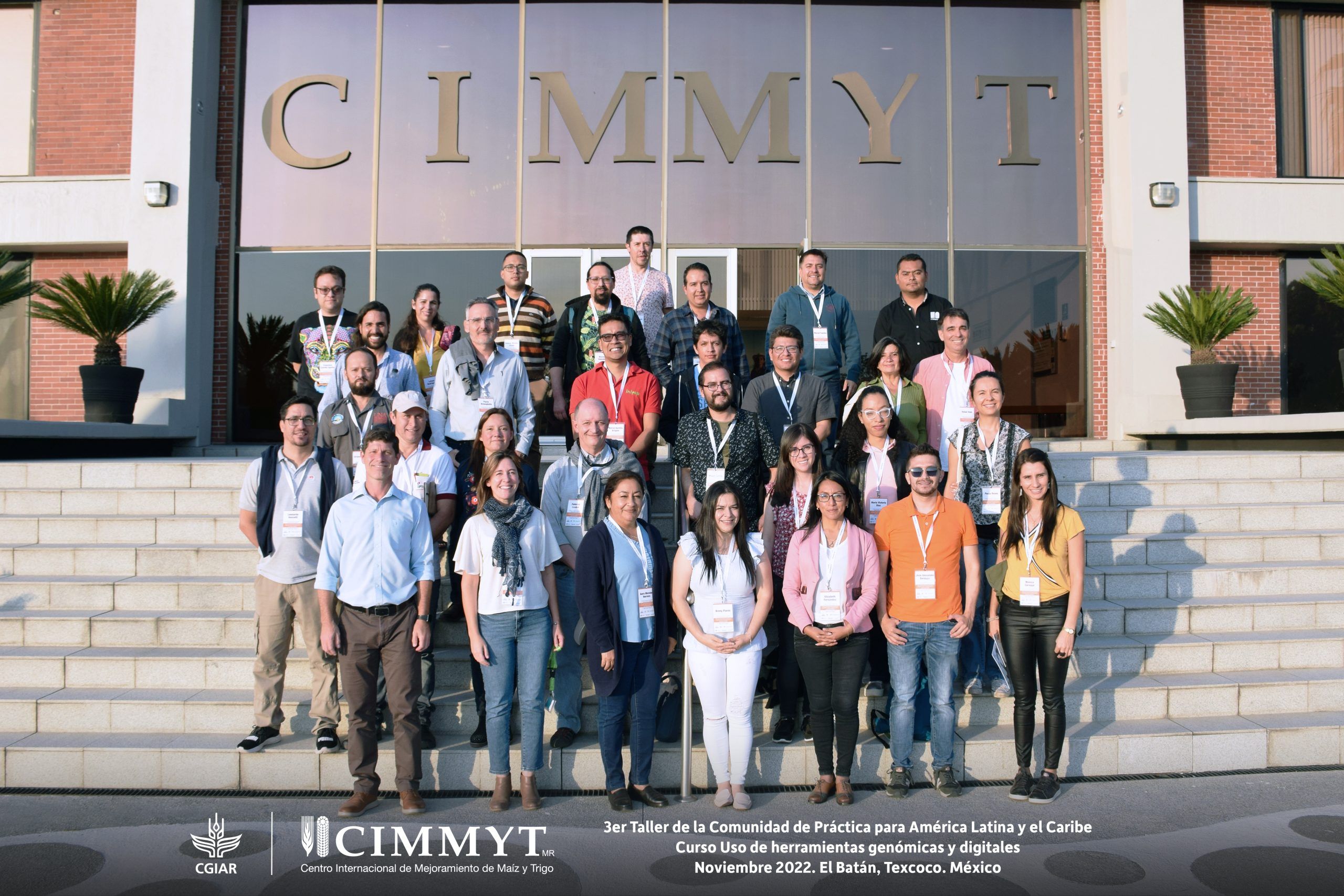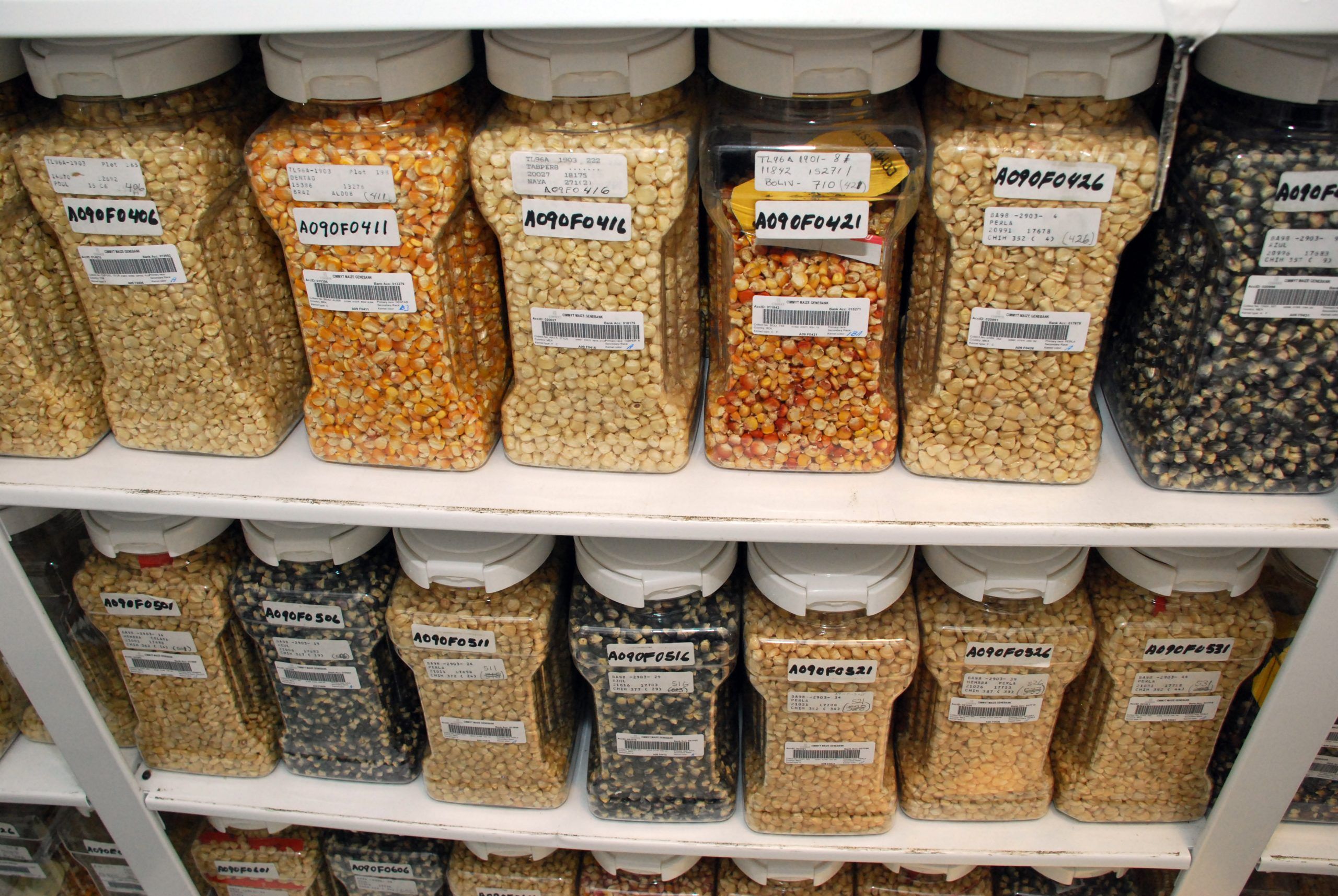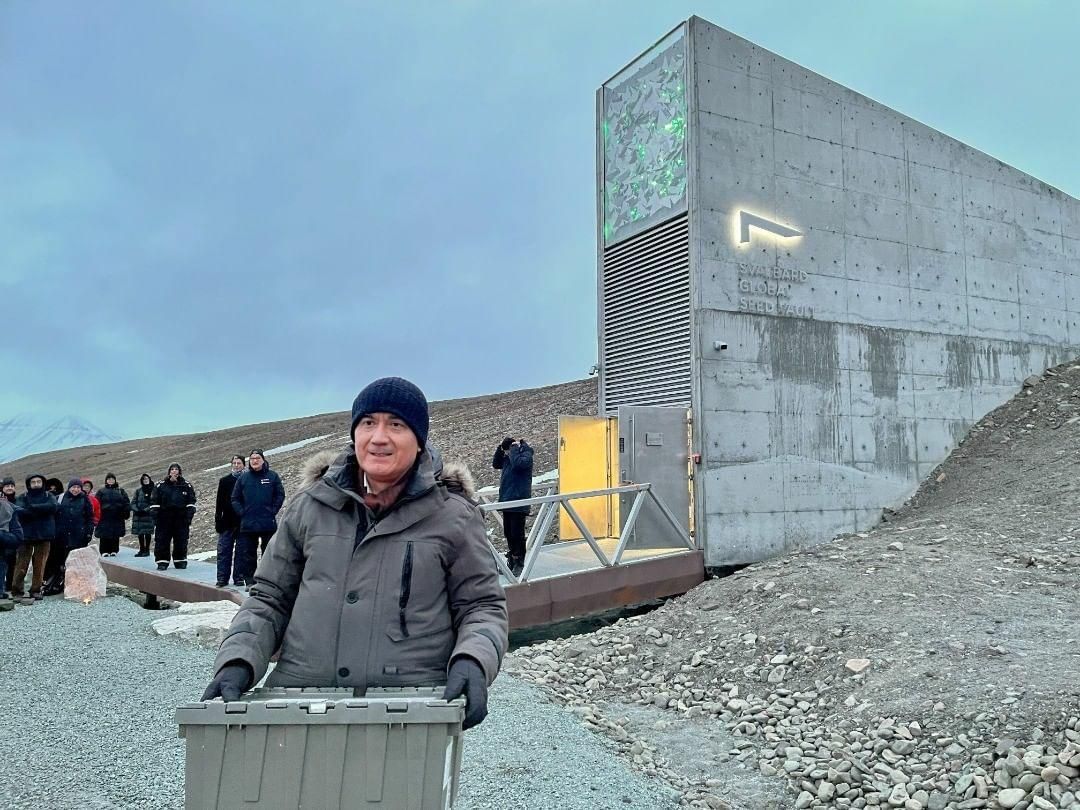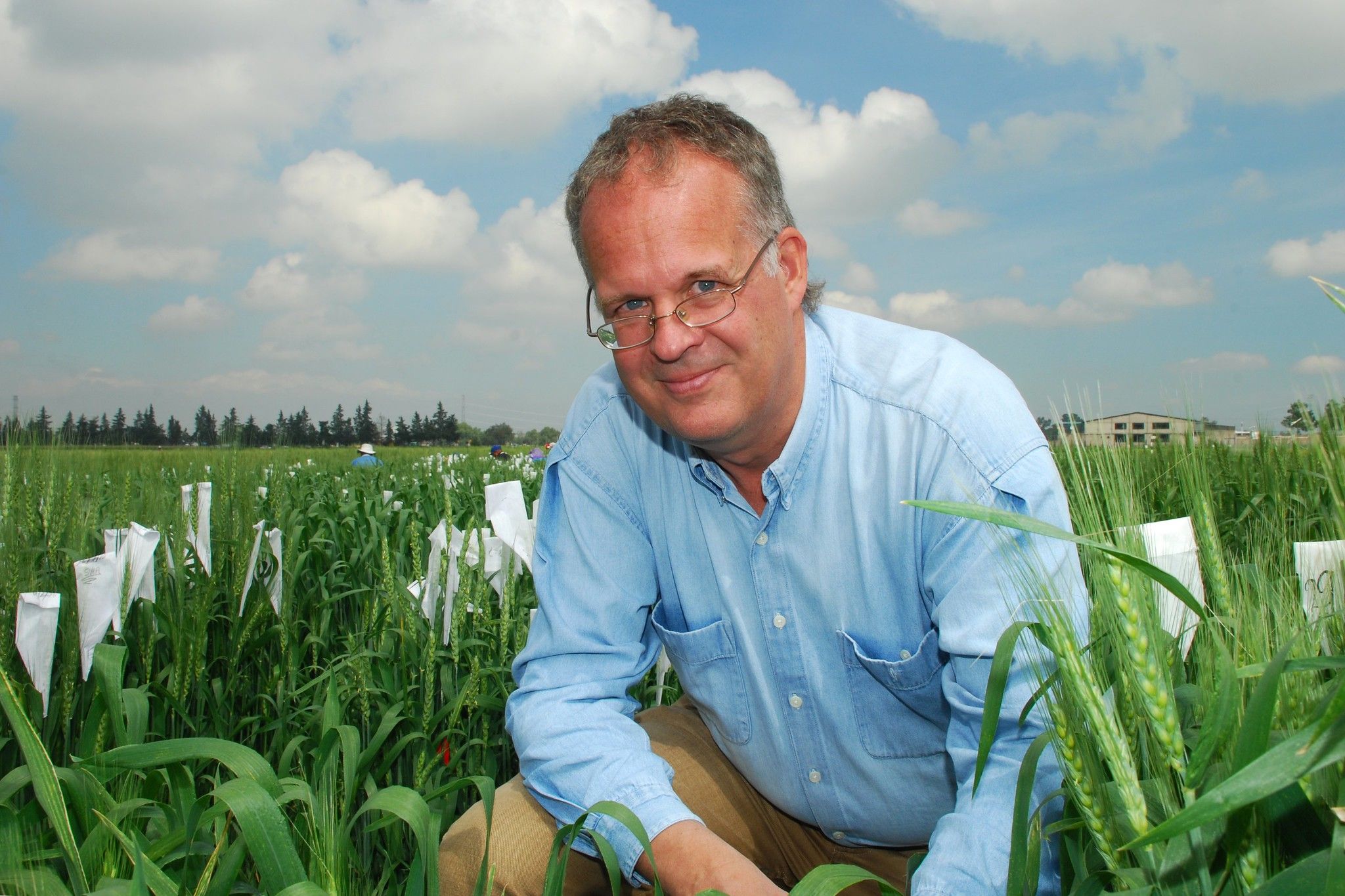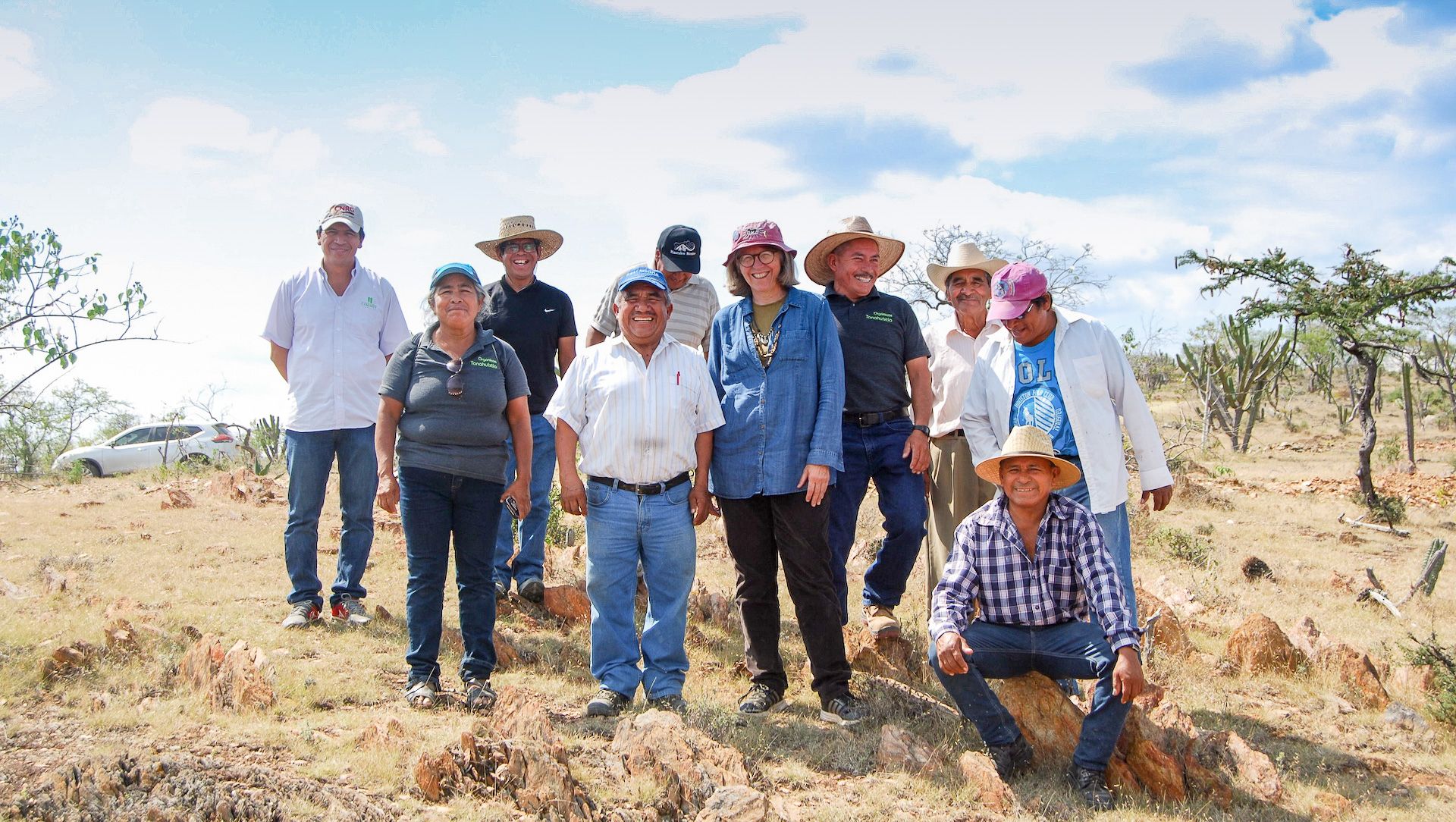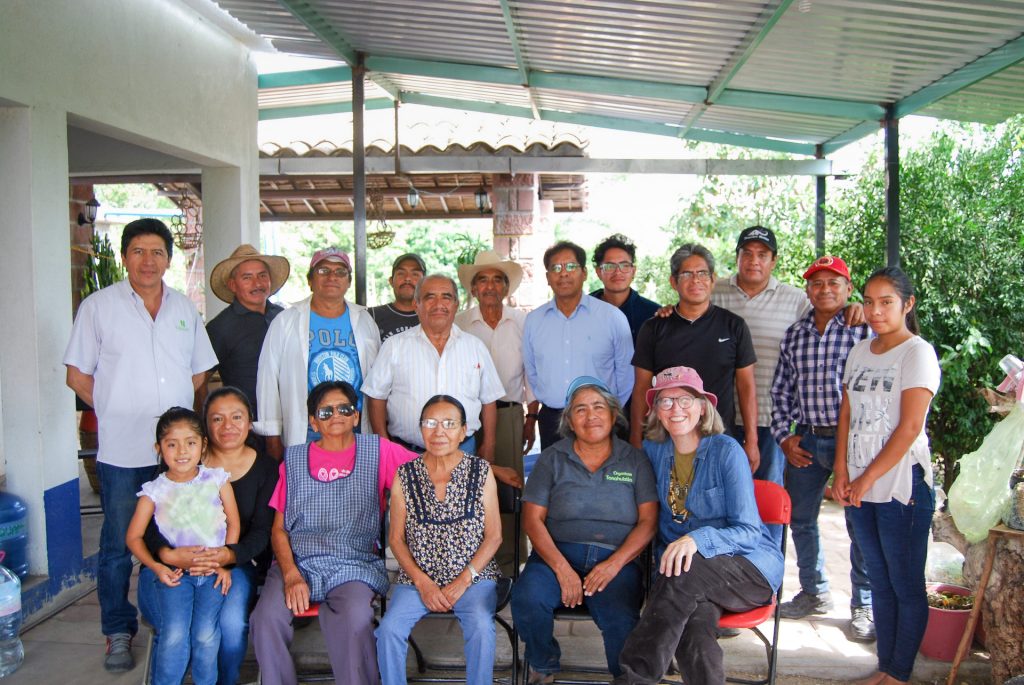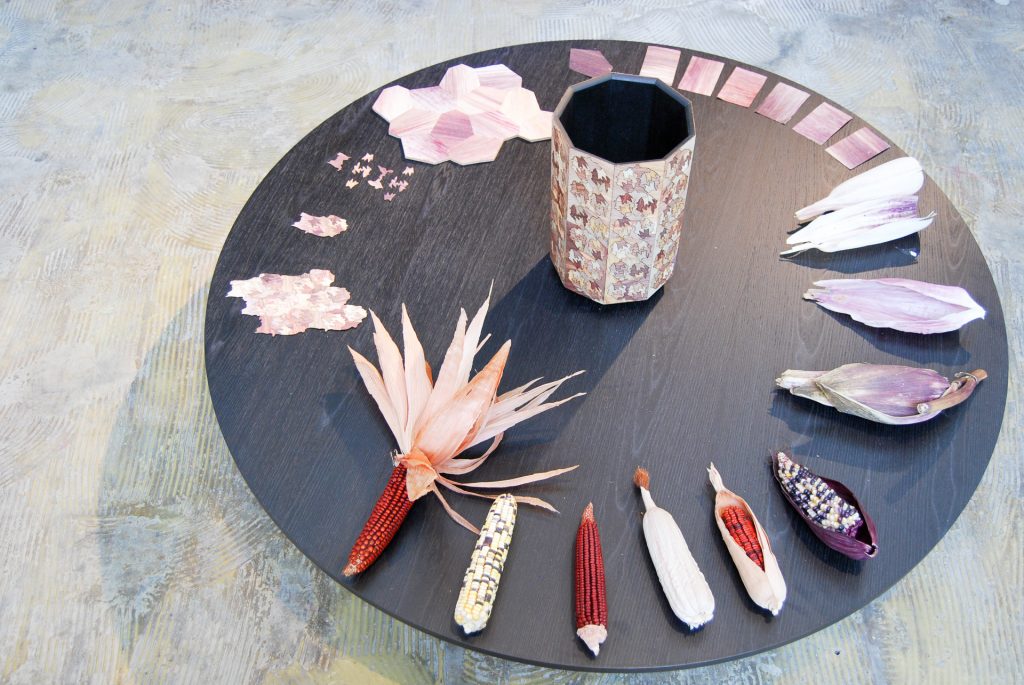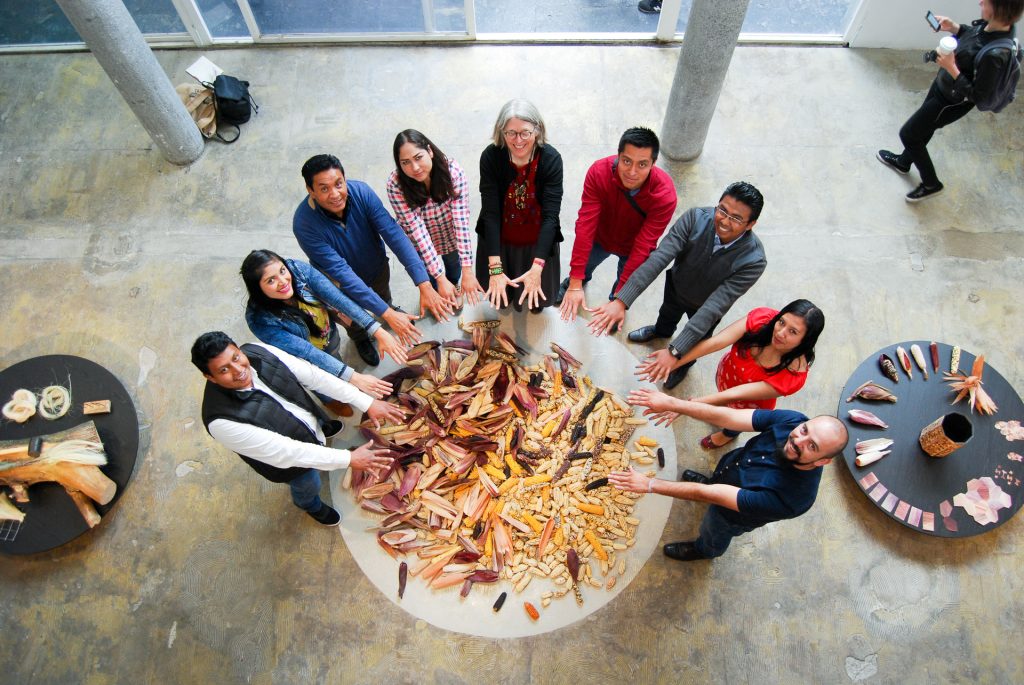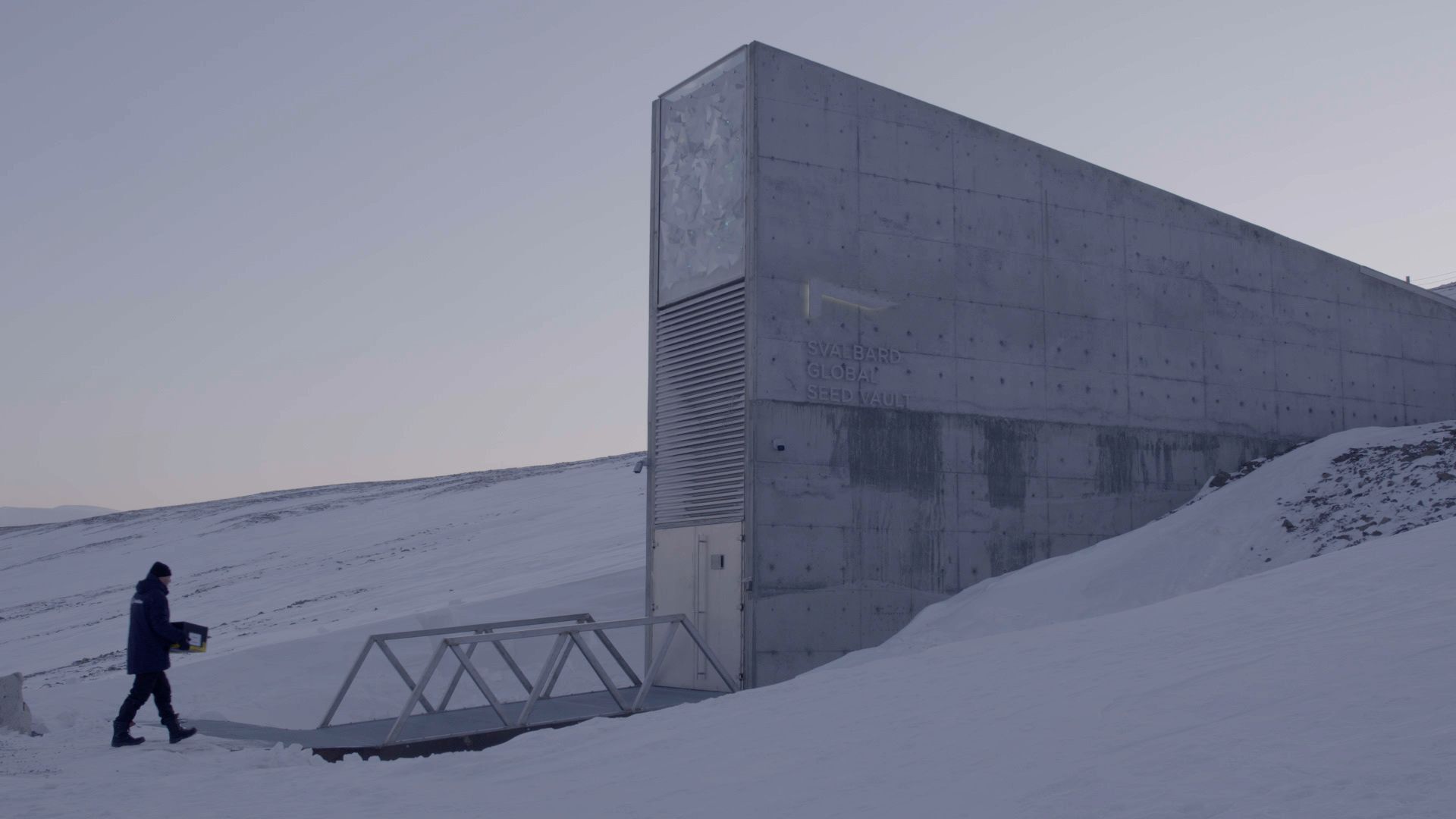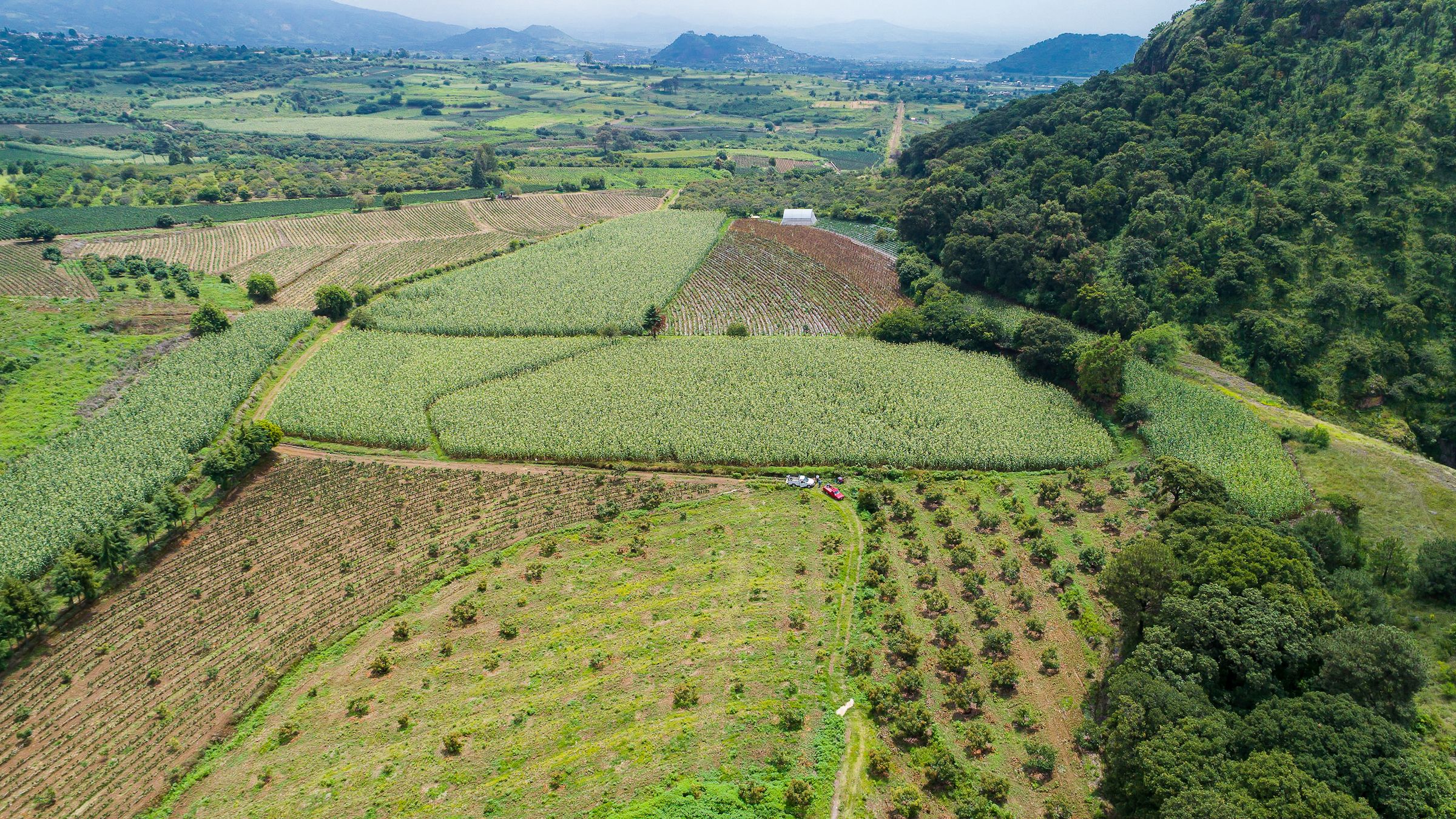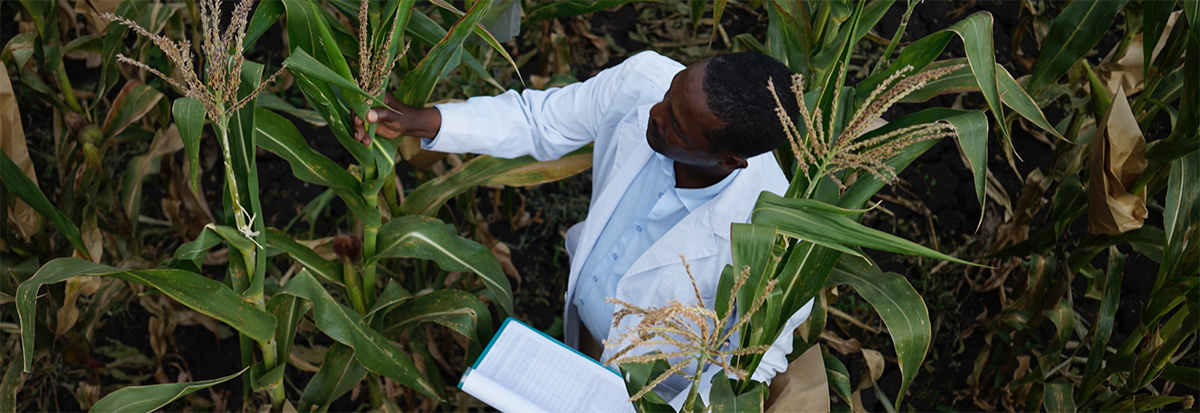funder_partner: Crop Trust
Ancient Wild Relatives Hold Key to Climate-Proofing Global Wheat Supply
CIMMYT, Mexico, August 27, 2024 — Crop wild relatives that have survived changing climates for millions of years may provide the solution to adapting wheat, humanity’s most widely grown crop, to climate change. Two new studies led by the International Maize and Wheat Improvement Center (CIMMYT) reveal how tapping into this ancient genetic diversity can revolutionize wheat breeding and safeguard global food security.
As the weather becomes more erratic and extreme, wheat — providing 20% of all calories and protein globally and serving as the primary staple food for 1.5 billion people in the Global South — faces unprecedented threats. These include heat waves, delayed rains, flooding, and new pests and diseases.
“We’re at a critical juncture,” says Dr. Matthew Reynolds, co-author of both studies. “Our current breeding strategies have served us well, but they must now address more complex challenges posed by climate change.”
The research points to a vast, largely untapped reservoir of nearly 800,000 wheat seed samples stored in 155 genebanks worldwide. These include wild relatives and ancient, farmer-developed varieties that have withstood diverse environmental stresses over millennia. Although only a fraction of this genetic diversity has been utilized in modern crop breeding, it has already delivered significant benefits.

Proven impacts of wild wheat genes
One of the studies, a review published today in Global Change Biology (GCB)*, documents the immense impact of wild relatives’ traits, including on environmental sustainability. It finds that the cultivation of disease-resistant wheat varieties has avoided the use of an estimated 1 billion liters of fungicide just since 2000.
“Without transferring disease-resistant genes from wild relatives to wheat, fungicide use would have easily doubled, harming both human and environmental health,” says Dr. Susanne Dreisigacker, Molecular Breeder at CIMMYT and co-author of the review.
Sharing of new wheat breeding lines through the CIMMYT-led International Wheat Improvement Network, comprising hundreds of partners and testing sites around the world, increases productivity worth USD 11 billion of extra grain every year. The extra productivity has saved millions of hectares of forests and other natural ecosystems from cultivation.
The review highlights other key breakthroughs using wheat wild relatives, including:
- Some experimental wheat lines incorporating wild traits show up to 20% more growth under heat and drought conditions compared to current varieties.
- Genes from a wheat wild relative have generated the first crop ever bred to interact with soil microbes, reducing the production of nitrous oxide, a potent greenhouse gas, and enabling the plants to use nitrogen more efficiently.
- New, high-yielding cultivars in Afghanistan, Egypt and Pakistan were developed using wild genes and have been released as they are more robust to the warming climate.
“Breeding the first beneficial interaction with the soil microbiome — in this case biological nitrification inhibition, or BNI-wheat — is a landmark achievement by CIMMYT and JIRCAS, opening up a whole new spectrum of opportunities to boost cropping systems’ resilience and reduce environmental footprints,” says Victor Kommerell, co-author of the GCB review, and Director of CropSustaiN, a new research initiative to determine the global climate mitigation and food security potential of BNI wheat.
The second study in Nature Climate Change* showcases the urgent need to scale-up exploration and use of genetic diversity for improved climate resilience. Among the traits needed are deeper, more extensive root systems for better water and nutrient access; photosynthesis that performs well across a wider temperature range; better heat tolerance in reproductive processes; and improved survival during delayed rains or temporary flooding.
“Tapping into the complex climate-resilient traits so urgently needed today requires both access to greater genetic diversity and a paradigm shift in breeding approaches,” explains co-author of the GCB review, Dr. Julie King of Nottingham University.
Modern crop breeding has focused on a relatively narrow pool of ‘star athletes’: elite crop varieties that are already high performers and that have known, predictable genetics. In contrast, the genetic diversity of wild wheat relatives offers complex climate-resilient traits — but their use has been more time-consuming, costly and riskier than traditional breeding approaches with elite varieties. Now, new technologies have changed that equation.
Making the impossible possible
“We have the tools to quickly explore genetic diversity that was previously inaccessible to breeders,” explains Dr. Benjamin Kilian, co-author of the review and coordinator of the Crop Trust’s Biodiversity for Opportunities, Livelihoods and Development (BOLD) project that supports conservation and use of crop diversity globally.
Among these tools are next-generation gene sequencing, big-data analytics, and remote sensing technologies, including satellite imagery. The latter allows researchers to routinely monitor traits like plant growth rate or disease resistance at unlimited numbers of sites globally.
However, realizing the full potential of these genetic resources will require global cooperation. “The most significant impacts will come through widespread sharing of genetic resources and technologies,” says Dr. Kilian.
New technologies allow crop researchers to precisely identify and transfer beneficial traits from wild relatives, making what has been seen as a risky, time-consuming process into a targeted, efficient strategy for climate-proofing crops. “Satellite technology turns the planet into a laboratory,” says Dr. Reynolds, “Combined with artificial intelligence to super-charge crop-breeding simulations, we can identify whole new solutions for climate resilience.”
This research, which also applies to any crop with surviving wild relatives, promises to enhance global food security and make cropping systems more environmentally sustainable. Developing more resilient and efficient wheat varieties will help feed a global population while reducing agriculture’s environmental footprint.
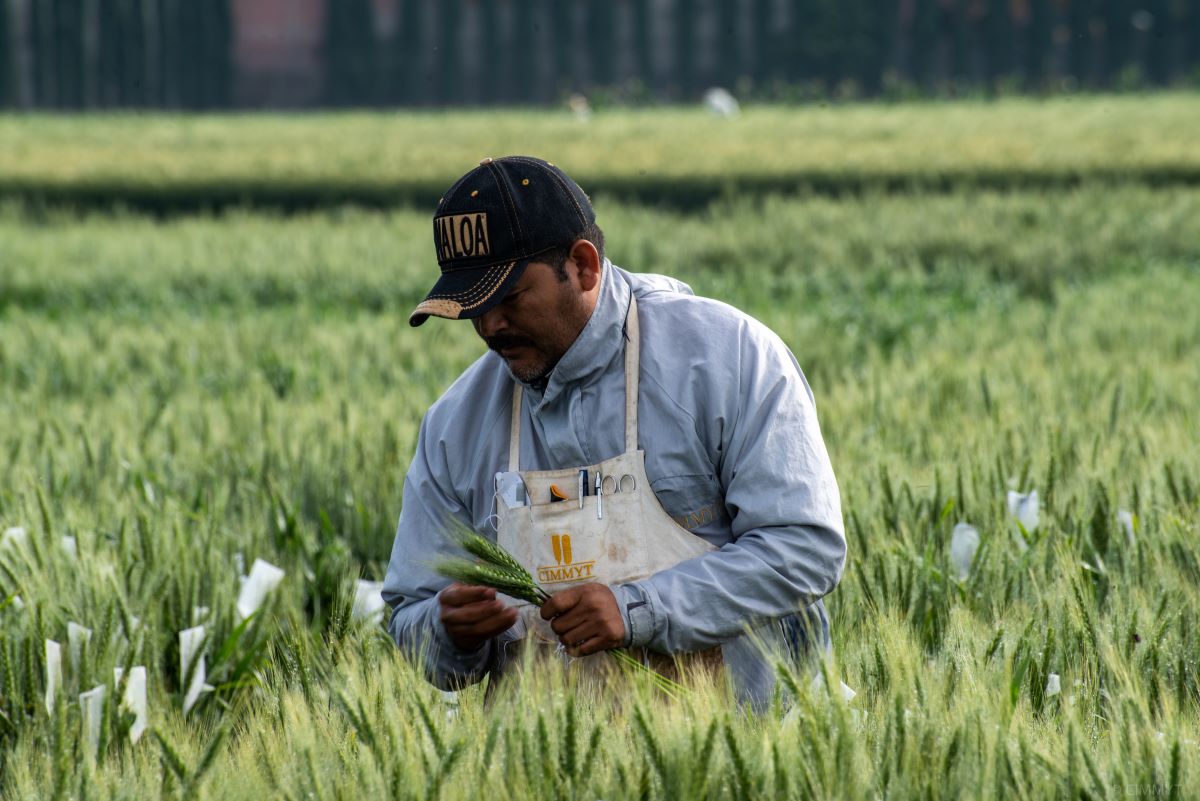
Study information and links
*Wheat genetic resources have avoided disease pandemics, improved food security, and reduced environmental footprints: A review of historical impacts and future opportunities. King J, Dreisigacker S, Reynolds M et al., 2024. Global Change Biology (Study available under embargo upon request)
*New wheat breeding paradigms for a warming climate. Xiong, W., Reynolds, M.P., Montes, C. et al. Nat. Clim. Chang. (2024). https://doi.org/10.1038/s41558-024-02069-0
Note to editors
About CIMMYT
Headquartered in Mexico, the International Maize and Wheat Improvement Center (known by its Spanish acronym, CIMMYT) is a not-for-profit agriculture research and training organization. The center works to reduce poverty and hunger by sustainably increasing the productivity of maize and wheat cropping systems in the developing world. Learn more at staging.cimmyt.org
About the Crop Trust
The Crop Trust is an international organization working to conserve crop diversity and protect global food and nutrition security. At the core of the Crop Trust is an endowment fund dedicated to providing guaranteed long-term financial support to key genebanks worldwide. The Crop Trust supports the Svalbard Global Seed Vault and coordinates large-scale projects worldwide to secure crop diversity and make it available for use, globally forever and for the benefit of everyone. The Crop Trust is recognized as an essential element of the funding strategy of the International Treaty on Plant Genetic Resources for Food and Agriculture. Learn more at www.croptrust.org
About the Biodiversity for Opportunities, Livelihoods and Development (BOLD) Project
BOLD is a 10-year project to strengthen food and nutrition security worldwide by supporting the conservation and use of crop diversity. The project works with national genebanks, pre-breeding and seed system partners globally. Funded by the Government of Norway, BOLD is led by the Crop Trust in partnership with the Norwegian University of Life Sciences and the International Plant Treaty.
Learn more at https://bold.croptrust.org/
For more information, contact:
Lynda Mwakisha (Nairobi, Kenya): lmwakisha@burness.com; +254 704 589 177
Jelle Boone, CIMMYT: J.BOONE@cgiar.org
Enhancing the resilience of our farmers and our food systems: global collaboration at DialogueNEXT
“Achieving food security by mid-century means producing at least 50 percent more food,” said U.S. Special Envoy for Global Food Security, Cary Fowler, citing a world population expected to reach 9.8 billion and suffering the dire effects of violent conflicts, rising heat, increased migration, and dramatic reductions in land and water resources and biodiversity. “Food systems need to be more sustainable, nutritious, and equitable.”
CIMMYT’s 2030 Strategy aims to build a diverse coalition of partners to lead the sustainable transformation of agrifood systems. This approach addresses factors influencing global development, plant health, food production, and the environment. At DialogueNEXT, CIMMYT and its network of partners showcased successful examples and promising directions for bolstering agricultural science and food security, focusing on poverty reduction, nutrition, and practical solutions for farmers.
Without healthy crops or soils, there is no food
CIMMYT’s MasAgro program in Mexico has enhanced farmer resilience by introducing high-yielding crop varieties, novel agricultural practices, and income-generation activities. Mexican farmer Diodora Petra Castillo Fajas shared how CIMMYT interventions have benefitted her family. “Our ancestors taught us to burn the stover, degrading our soils. CIMMYT introduced Conservation Agriculture, which maintains the stover and traps more humidity in the soil, yielding more crops with better nutritional properties,” she explained.
 CIMMYT and African partners, in conjunction with USAID’s Feed the Future, have begun applying the MasAgro [1] model in sub-Saharan Africa through the Feed the Future Accelerated Innovation Delivery Initiative (AID-I), where as much as 80 percent of cultivated soils are poor, little or no fertilizer is applied, rainfed maize is the most widespread crop, many households lack balanced diets, and erratic rainfall and high temperatures require different approaches to agriculture and food systems.
CIMMYT and African partners, in conjunction with USAID’s Feed the Future, have begun applying the MasAgro [1] model in sub-Saharan Africa through the Feed the Future Accelerated Innovation Delivery Initiative (AID-I), where as much as 80 percent of cultivated soils are poor, little or no fertilizer is applied, rainfed maize is the most widespread crop, many households lack balanced diets, and erratic rainfall and high temperatures require different approaches to agriculture and food systems.
The Food and Agriculture Organization of the United Nations (FAO) and CIMMYT are partnering to carry out the Vision for Adapted Crops and Soils (VACS) movement in Africa and Central America. This essential movement for transforming food systems endorsed by the G7 focuses on crop improvement and soil health. VACS will invest in improving and spreading 60 indigenous “opportunity” crops—such as sorghum, millet, groundnut, pigeon pea, and yams, many of which have been grown primarily by women—to enrich soils and human diets together with the VACS Implementers’ Group, Champions, and Communities of Practice.
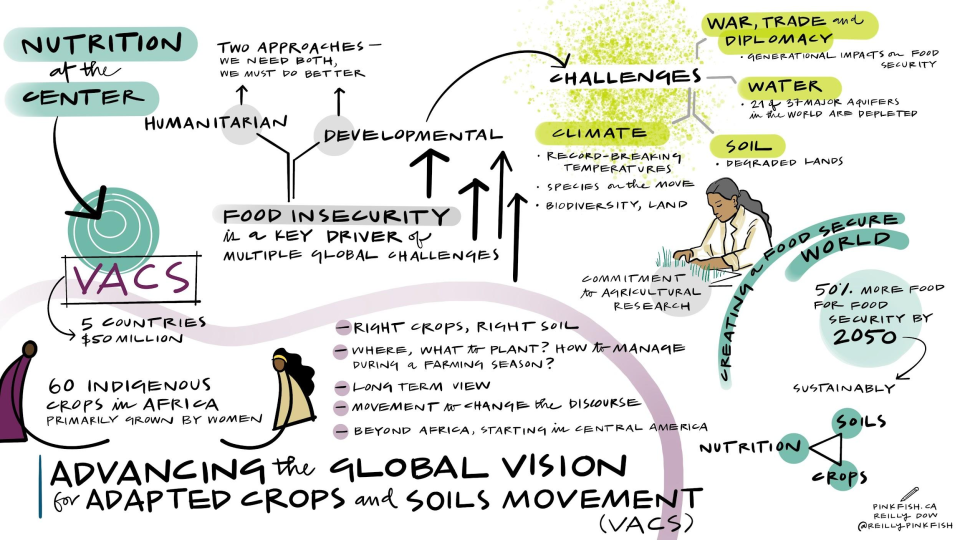 The MasAgro methodology has been fundamental in shaping the Feed the Future Southern Africa Accelerated Innovation Delivery Initiative (AID-I) Rapid Delivery Hub, an effort between government agencies, private, and public partners, including CGIAR. AID-I provides farmers with greater access to markets and extension services for improved seeds and crop varieties. Access to these services reduces the risk to climate and socioeconomic shocks and improves food security, economic livelihoods, and overall community resilience and prosperity.
The MasAgro methodology has been fundamental in shaping the Feed the Future Southern Africa Accelerated Innovation Delivery Initiative (AID-I) Rapid Delivery Hub, an effort between government agencies, private, and public partners, including CGIAR. AID-I provides farmers with greater access to markets and extension services for improved seeds and crop varieties. Access to these services reduces the risk to climate and socioeconomic shocks and improves food security, economic livelihoods, and overall community resilience and prosperity.
Healthy soils are critical for crop health, but crops must also contain the necessary genetic traits to withstand extreme weather, provide nourishment, and be marketable. CIMMYT holds the largest maize and wheat gene bank, supported by the Crop Trust, offering untapped genetic material to develop more resilient varieties from these main cereal grains and other indigenous crops. Through the development of hardier and more adaptable varieties, CIMMYT and its partners commit to implementing stronger delivery systems to get improved seeds for more farmers. This approach prioritizes biodiversity conservation and addresses major drivers of instability: extreme weather, poverty, and hunger.
Food systems must be inclusive to combat systemic inequities
Successful projects and movements such as MasAgro, VACS, and AID-I are transforming the agricultural landscape across the Global South. But the urgent response required to reduce inequities and the needed investment to produce more nutritious food with greater access to cutting-edge technologies demands inclusive policies and frameworks like CIMMYT’s 2030 Strategy.
“In Latin America and throughout the world, there is still a huge gap between the access of information and technology,” said Secretary of Agriculture and Livestock of Honduras, Laura Elena Suazo Torres. “Civil society and the public and private sectors cannot have a sustainable impact if they work opposite to each other.”
Ismahane Elouafi, CGIAR executive managing director, emphasized that agriculture does not face, “a lack of innovative science and technology, but we’re not connecting the dots.” CIMMYT offers a pathway to bring together a system of partners from various fields—agriculture, genetic resources, crop breeding, and social sciences, among others—to address the many interlinked issues affecting food systems, helping to bring agricultural innovations closer to farmers and various disciplines to solve world hunger.
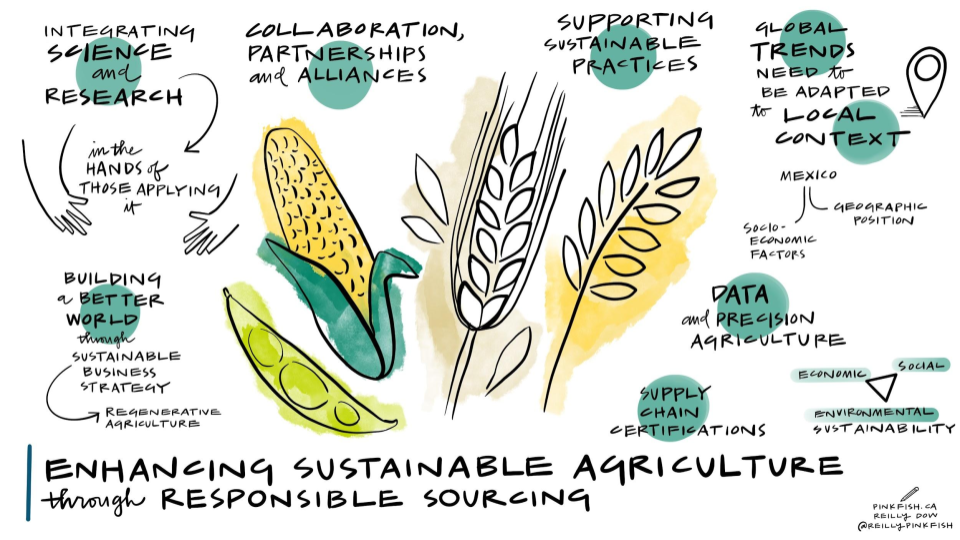 While healthy soils and crops are key to improved harvests, ensuring safe and nutritious food production is critical to alleviating hunger and inequities in food access. CIMMYT engages with private sector stakeholders such as Bimbo, GRUMA, Ingredion, Syngenta, Grupo Trimex, PepsiCo, and Heineken, to mention a few, to “link science, technology, and producers,” and ensure strong food systems, from the soils to the air and water, to transform vital cereals into safe foods to consume, like fortified bread and tortillas.
While healthy soils and crops are key to improved harvests, ensuring safe and nutritious food production is critical to alleviating hunger and inequities in food access. CIMMYT engages with private sector stakeholders such as Bimbo, GRUMA, Ingredion, Syngenta, Grupo Trimex, PepsiCo, and Heineken, to mention a few, to “link science, technology, and producers,” and ensure strong food systems, from the soils to the air and water, to transform vital cereals into safe foods to consume, like fortified bread and tortillas.
Reduced digital gaps can facilitate knowledge-sharing to scale-out improved agricultural practices like intercropping. The Rockefeller Foundation and CIMMYT have “embraced the complexity of diversity,” as mentioned by Roy Steiner, senior vice-president, through investments in intercropping, a crop system that involves growing two or more crops simultaneously and increases yields, diversifies diets, and provides economic resilience. CIMMYT has championed these systems in Mexico, containing multiple indicators of success from MasAgro.

Today, CIMMYT collaborates with CGIAR and Total LandCare to train farmers in southern and eastern Africa on the intercrop system with maize and legumes i.e., cowpea, soybean, and jack bean. CIMMYT also works with WorldVeg, a non-profit organization dedicated to vegetable research and development, to promote intercropping in vegetable farming to ensure efficient and safe production and connect vegetable farmers to markets, giving them more sources for greater financial security.
Conflict aggravates inequities and instability. CIMMYT leads the Feed the Future Sustainable Agrifood Systems Approach for Sudan (SASAS) which aims to deliver latest knowledge and technology to small scale producers to increase agricultural productivity, strengthen local and regional value chains, and enhance community resilience in war-torn countries like Sudan. CIMMYT has developed a strong partnership funded by USAID with ADRA, CIP, CRS, ICRISAT, IFDC, IFPRI, ILRI, Mercy Corps, Near East Foundation, Samaritan’s Purse, Syngenta Foundation, VSF, and WorldVeg, to devise solutions for Sudanese farmers. SASAS has already unlocked the potential of several well-suited vegetables and fruits like potatoes, okra, and tomatoes. These crops not only offer promising yields through improved seeds, but they encourage agricultural cooperatives, which promote income-generation activities, gender-inclusive practices, and greater access to diverse foods that bolster family nutrition. SASAS also champions livestock health providing food producers with additional sources of economic resilience.
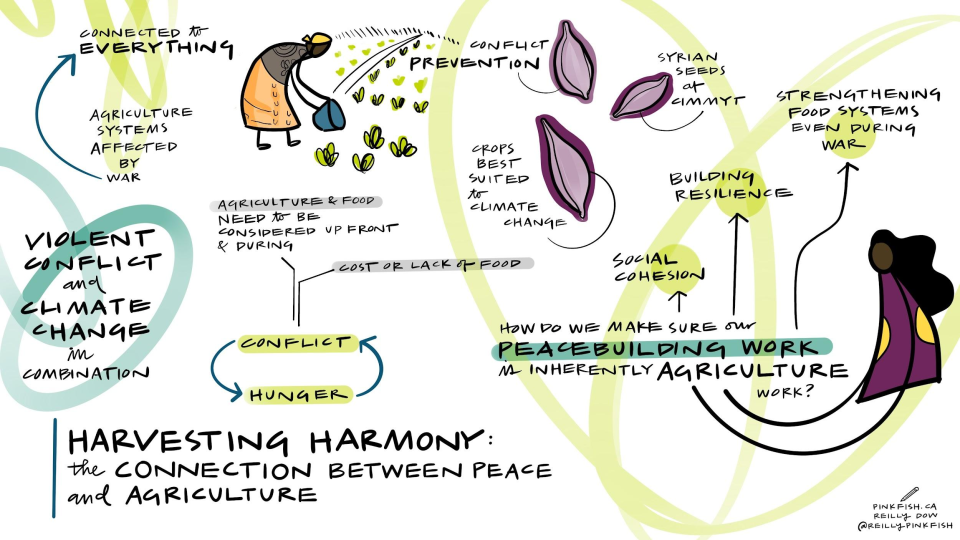 National governments play a critical role in ensuring that vulnerable populations are included in global approaches to strengthen food systems. Mexico’s Secretary of Agriculture, Victor Villalobos, shared examples of how government intervention and political will through people-centered policies provides greater direct investment to agriculture and reduces poverty, increasing shared prosperity and peace. “Advances must help to reduce gaps in development.” Greater access to improved agricultural practices and digital innovation maintains the field relevant for farmers and safeguards food security for society at large. Apart from Mexico, key government representatives from Bangladesh, Brazil, Honduras, India, and Vietnam reaffirmed their commitment to CIMMYT’s work.
National governments play a critical role in ensuring that vulnerable populations are included in global approaches to strengthen food systems. Mexico’s Secretary of Agriculture, Victor Villalobos, shared examples of how government intervention and political will through people-centered policies provides greater direct investment to agriculture and reduces poverty, increasing shared prosperity and peace. “Advances must help to reduce gaps in development.” Greater access to improved agricultural practices and digital innovation maintains the field relevant for farmers and safeguards food security for society at large. Apart from Mexico, key government representatives from Bangladesh, Brazil, Honduras, India, and Vietnam reaffirmed their commitment to CIMMYT’s work.


Alice Ruhweza, senior director at the World Wildlife Fund for Nature, and Maria Emilia Macor, an Argentinian farmer, agreed that food systems must adopt a holistic approach. Ruhweza called it, “The great food puzzle, which means that one size does not fit all. We must integrate education and infrastructure into strengthening food systems and development.” Macor added, “The field must be strengthened to include everyone. We all contribute to producing more food.”
Generating solutions, together
In his closing address, which took place on World Population Day 2024, CIMMYT Director General Bram Govaerts thanked the World Food Prize for holding DialogueNEXT in Mexico and stressed the need for all partners to evolve, while aligning capabilities. “We have already passed several tipping points and emergency measures are needed to avert a global catastrophe,” he said. “Agrifood systems must adapt, and science has to generate solutions.”
Through its network of research centers, governments, private food producers, universities, and farmers, CIMMYT uses a multidisciplinary approach to ensure healthier crops, safe and nutritious food, and the dissemination of essential innovations for farmers. “CIMMYT cannot achieve these goals alone. We believe that successful cooperation is guided by facts and data and rooted in shared values, long-term commitment, and collective action. CIMMYT’s 2030 Strategy goes beyond transactional partnership and aims to build better partnerships through deeper and more impactful relationships. I invite you to partner with us to expand this collective effort together,” concluded Govaerts.
[1] Leveraging CIMMYT leadership, science, and partnerships and the funding and research capacity of Mexico’s Agriculture Ministry (SADER) during 2010-21, the program known as “MasAgro” helped over 300,000 participating farmers to adopt improved maize and wheat varieties and resource-conserving practices on more than 1 million hectares of farmland in 30 states of Mexico.
Visual summaries by Reilly Dow.
CIMMYT hosts third workshop of the Community of Practice for Latin America and the Caribbean
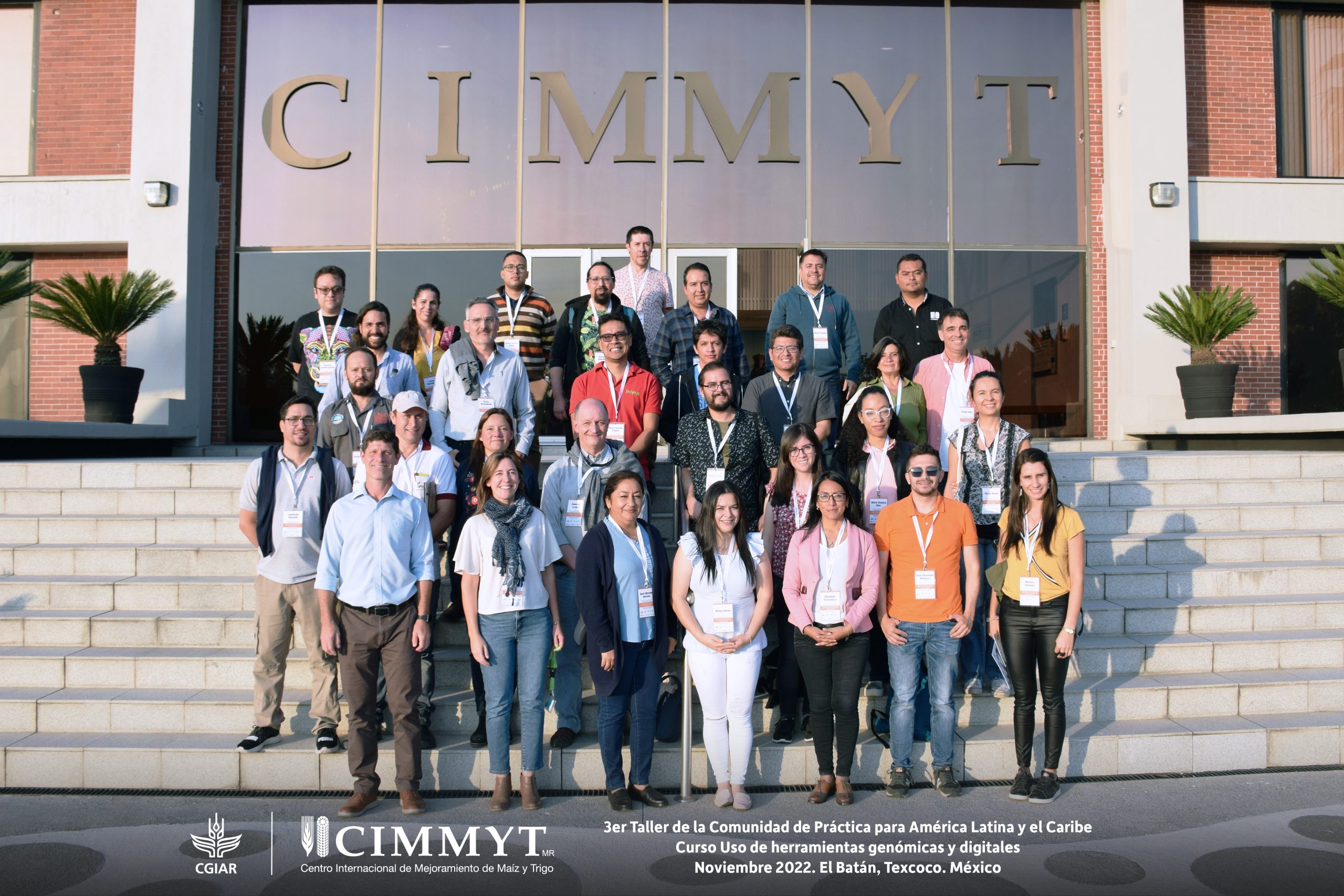
From November 14 to 18, the International Maize and Wheat Improvement Center (CIMMYT) and the Alliance of Bioversity International and CIAT hosted the third workshop of the Community of Practice for Latin America and the Caribbean on the use of genomic and digital tools for the conservation and use of Genetic Resources for Food and Agriculture (GRAA).
The workshop, attended by 33 participants from 14 countries, was held at CIMMYT headquarters and highlighted topics such as the analysis of genotypic data derived from the DArTseq platform and the analysis of gaps in germplasm collections.
“It was very gratifying to be able to form this Latin American network of germplasm banks together with our colleagues from the Alliance of Bioversity International and CIAT,”said Carolina Sansaloni, Wheat Germplasm Bank Curator & Genotyping Specialist. “Training and knowledge exchange among germplasm banks is essential for better conservation, exploration and utilization of genetic resources in each country.”
Some of the participants shared the following comments and feedback:
- “Excellent initiative, it is a fundamental support for the strengthening of plant genetic resources conservation systems and the creation of international collaborative networks. Thanks to CIMMYT and the Alliance of Bioversity International and CIAT for the invitation.” Mexico’s National Institute for Forestry, Agriculture and Livestock Research (INIFAP)
- “Excellent workshop, a very important space for the exchange of knowledge and experiences, it also allows the formation of collaborative work networks between institutions and professionals from different countries with related research.” Escuela de Ciencias Agrarias, Universidad Nacional Costa Rica
- “This workshop has allowed me to get in contact with colleagues from Latin America and to open the possibility of working together to advance in the characterization and contribute to the conservation of the collections we manage.” Instituto Nacional de Tecnología Agropecuaria, Argentina
- “This has been a very profitable week for me as curator of the germplasm bank in Brazil. I learnt new concepts and tools that will generate advances in my work.” Brazilian Agricultural Research Corporation (EMBRAPA)
This workshop would not have been possible without the support of the CGIAR’s Genebank Initiative, DivSeek International and Analitek-Illumina.
FFAR’s food security webinar at COP27 highlights need for genebank collection diversity research
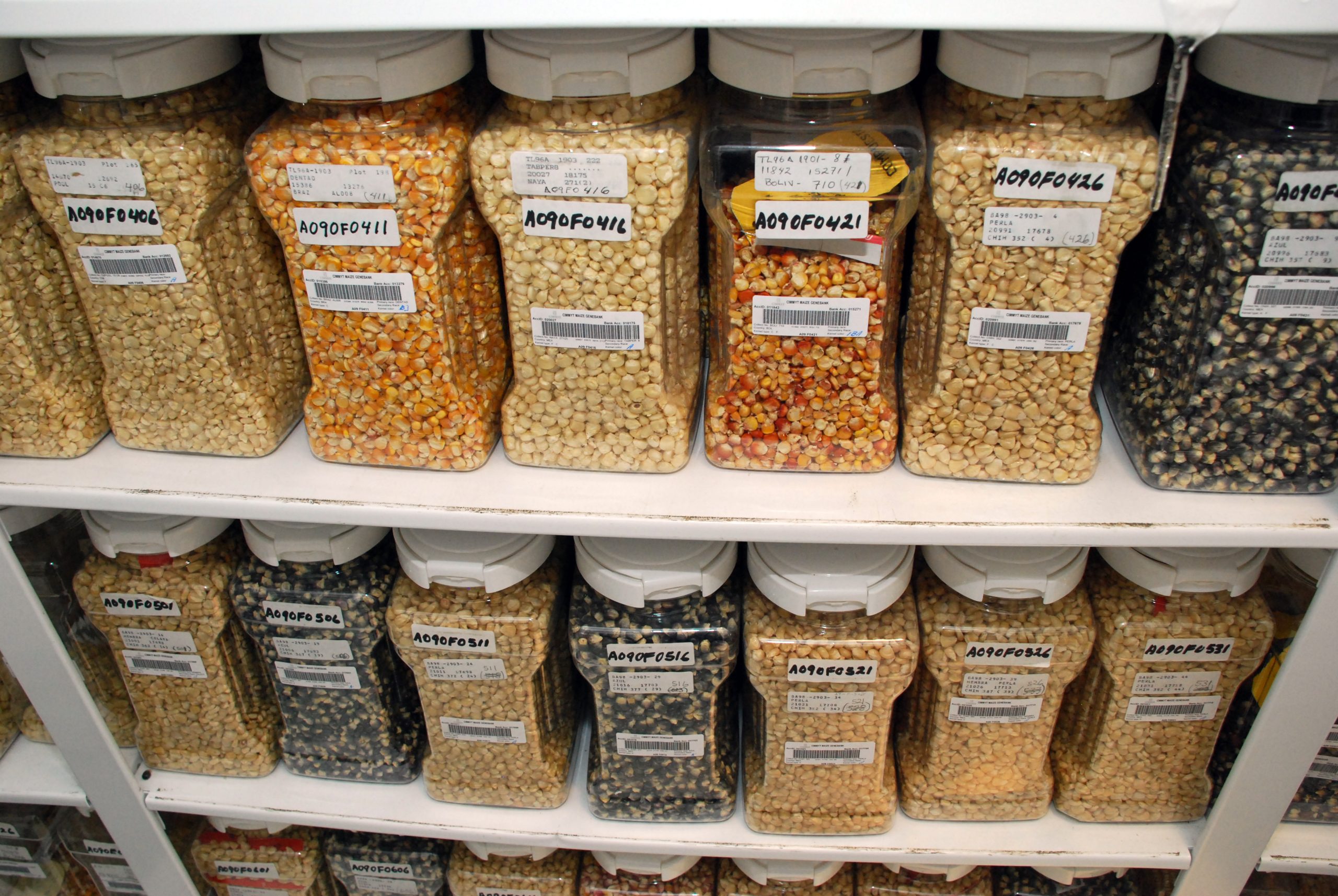
As part of the Agriculture Innovation Mission for Climate (AIM for Climate) Roadshow at the 27th annual UN Climate Change Conference of the Parties (COP27), the Foundation for Food & Agriculture Research (FFAR) and its partners are hosting a webinar on November 11, 2022 to highlight the Fast Tracking Climate Solutions from CGIAR Genebank Collections program and the importance of crop improvement research for building climate resilient supply chains.
Fast Tracking Climate Solutions from CGIAR Genebank Collections is expanding CGIAR’s and other organizations’ crop improvement research. This initiative is key to developing new crop varieties adapted to the stresses of climate change, including disruptions caused by drought, heat and flooding. Through this ambitious research program, scientists have already developed critical traits using the genebanks, strengthening the identification of high-value genetic diversity from germplasm collections and more efficiently leveraging this diversity to develop new varieties of climate-resilient crops.
Join virtually to learn more about this program’s pioneering research, the value of collaboration in this research and opportunities to engage further.
WHEN: November 11, 2022, from 11 a.m. to 12 p.m. EST
WHO: Jeffrey Rosichan, FFAR (moderator)
Bram Govaerts, director general a.i. (secretary general and CEO), the International Maize and Wheat Improvement Center (CIMMYT), CGIAR
Éliane Ubalijoro, member of the Global Diversity Crop Trust executive board, Global Crop Diversity Trust
Gary Atlin, senior program officer in the agricultural development initiative, Bill & Melinda Gates Foundation
Sarah Hearne, principal scientist, CIMMYT, CGIAR
RSVP: Please register for the webinar to receive call-in information. This event is free and open to the public.
AIM for Climate is a joint initiative by the United States and United Arab Emirates seeking to address climate change and global hunger. The initiative brings together partners to increase investment in climate-smart agriculture and food systems innovation. Specifically, AIM for Climate is advancing research through Innovation Sprints. As an AIM for Climate Knowledge Partner and an Innovation Sprint Partner, FFAR has two other Innovation Sprints in addition to the genebanking project: AgMission and the Greener Cattle Initiative.
For more information, contact Jamie Nickel, communications & legislative affairs associate, at jnickel@foundationfar.org.
About the Foundation for Food & Agriculture Research
The Foundation for Food & Agriculture Research (FFAR) builds public-private partnerships to fund bold research addressing big food and agriculture challenges. FFAR was established in the 2014 Farm Bill to increase public agriculture research investments, fill knowledge gaps and complement USDA’s research agenda. FFAR’s model matches federal funding from Congress with private funding, delivering a powerful return on taxpayer investment. Through collaboration and partnerships, FFAR advances actionable science benefiting farmers, consumers and the environment.
Cover photo: Shelves filled with maize seed samples make up the maize active collection in the Wellhausen-Anderson Plant Genetic Resources Center at CIMMYT’s El Batán headquarters, Mexico. (Photo: Xochiquetzal Fonseca/CIMMYT)
CIMMYT delivers seed to Svalbard Global Seed Vault
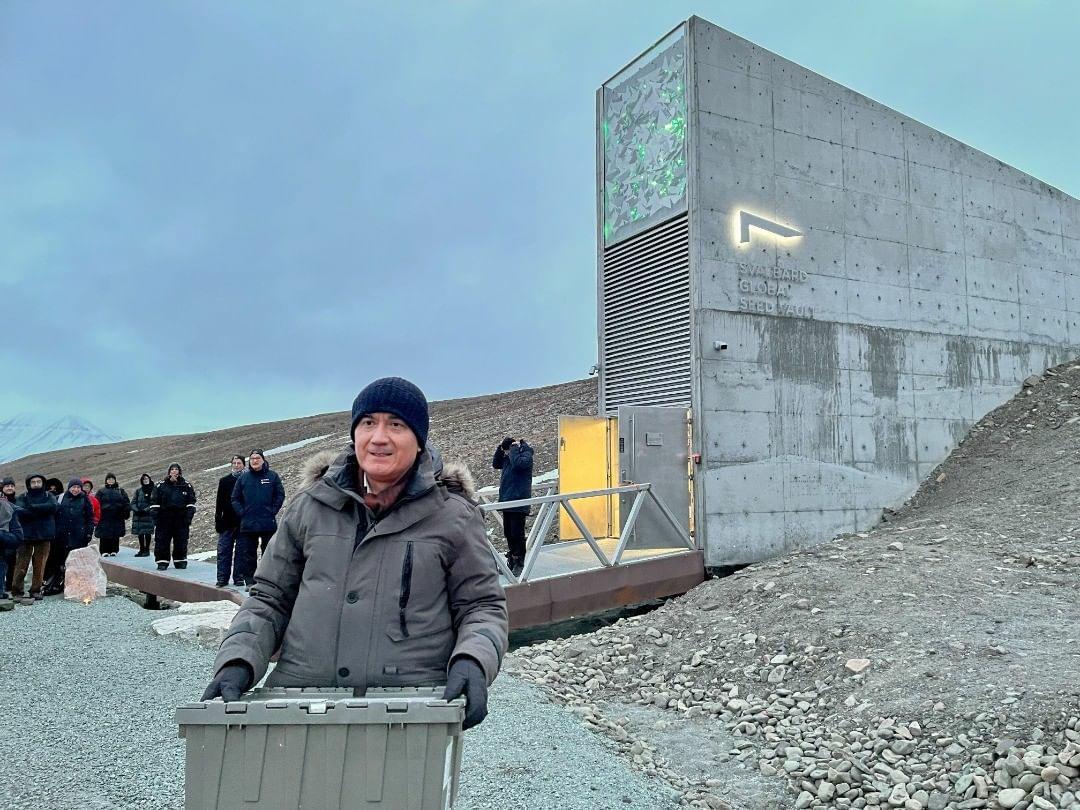
The Ambassador of Mexico to Norway, Ulises Canchola Gutiérrez, delivered a deposit from the International Maize and Wheat Improvement Center (CIMMYT) to the Svalbard Global Seed Vault on October 12.
CIMMYT was the ninth depositor in the Seed Vault in 2022, with a contribution of 263 accessions of maize and 3,548 accession of wheat.
“Professionally, I am pleased to carry out this activity that contributes to the conservation of genetic resources and guarantees food security of two of the major crops that feed the world,” said Rocio Quiroz, assistant research associate at CIMMYT. “When we prepare a shipment as a team, it is extraordinary because we contribute to the perpetuity of each accession deposited in the vault. Very few people have the privilege of doing so.”
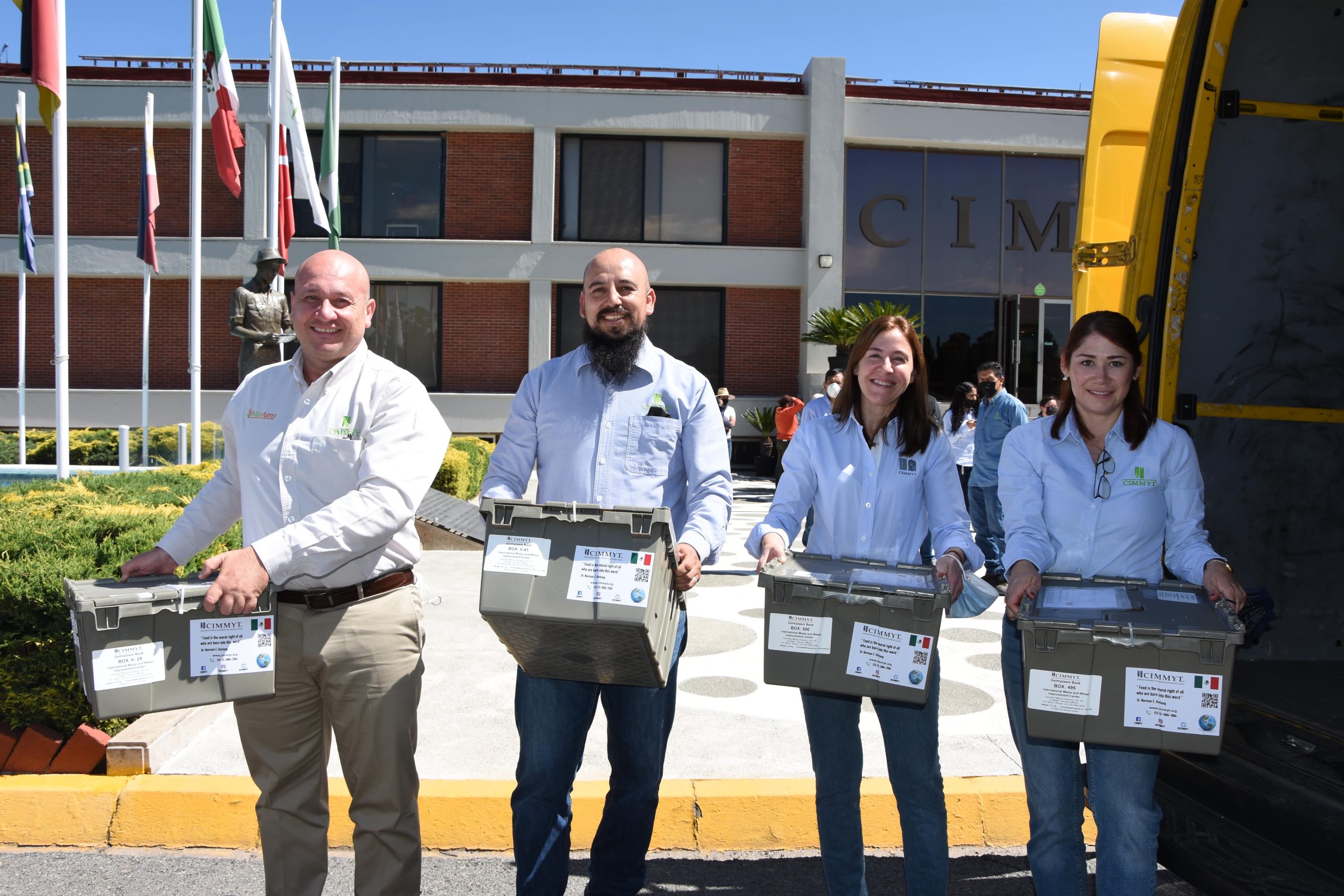
What is the Seed Vault?
The Seed Vault is a genebank collection that holds duplicates of seeds from more than 1,700 genebanks around the world, playing the role of a backup collection. By protecting these varieties from catastrophic loss, the Seed Vault contributes towards food security for future generations.
Owned by Norway and managed in partnership between the Norwegian Ministry of Agriculture and Food, NordGen, and the Crop Trust, the Seed Vault currently holds 1,165,041 seed varieties, with capacity for millions more.
In 2020, CIMMYT was the largest contributor, providing 173,779 maize and wheat accessions from 131 countries.
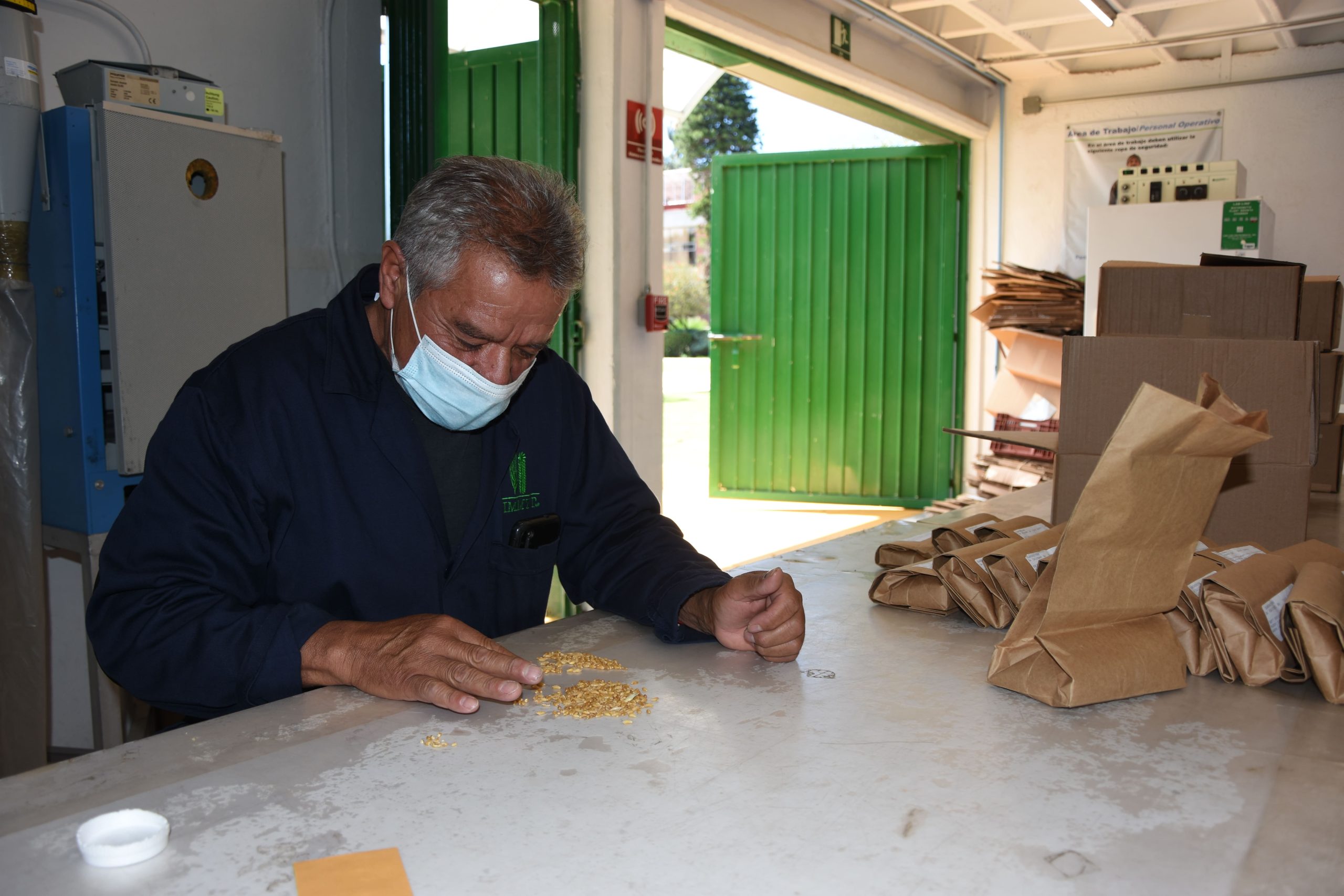
How is germplasm stored at CIMMYT?
CIMMYT’s own germplasm bank contains approximately 150,000 unique collections of wheat seed and its ancestors and is the largest unified collection in the world for a single crop.
For maize, the germplasm bank contains more than 28,000 samples, including the world’s largest collection of maize landraces, representing nearly 90% of maize diversity in the Americas.
Carolina Sansaloni, manager of the wheat genebank at CIMMYT, said, “I am proud of all CIMMYT germplasm bank staff that made a great effort to send an additional 3,800 accessions to the Svalbard as safety duplications. This contribution is for the food security of humanity.”
A conservation conversation
Germplasm banks around the world are protectors of genetic diversity, altogether preserving roughly 700,000 samples of wheat varieties from fields far and wide. Thomas (Tom) Payne, the head of CIMMYTs Wheat Germplasm Collection, or genebank, manages the Mexico-based collection of nearly 150,000 accessions from over 100 countries. He has been affiliated with CIMMYT since 1988, and has dedicated his career to wheat improvement and conservation, working in Ethiopia, Mexico, Syria, Turkey and Zimbabwe. In addition to managing the genebank, he is the chair of the CGIAR Genebank Managers Group, has served as secretary to the CIMMYT Board of Trustees, manages the CIMMYT International Wheat Improvement Network and was awarded the Frank N. Meyer Medal for Plant Genetic Resources in 2019.
In advance of his retirement in July 2021, CIMMYT senior scientist Carolina Saint Pierre sat down with Tom Payne over Zoom to ask him a few questions from the wheat breeding team about his lifetime of experience in wheat biodiversity conservation.
What is your favorite Triticum species?
Triticum aestivum, bread wheat, is my favorite. Bread wheat feeds around 2.7 billion people worldwide. In fact, more food products are made from wheat than from any other cereal. An interesting detail about Triticum aestivum, however, is that it’s a hexaploid, meaning that it is a distinct species formed from three separate species. The inherent genetic diversity resulting from its three ancestral species and its ability to naturally incorporate genetic diversity from other species gives breeders a broad palette of genetic diversity to work with for current and future needs.
How can genebank managers of vital food crops add diversity to existing collections?
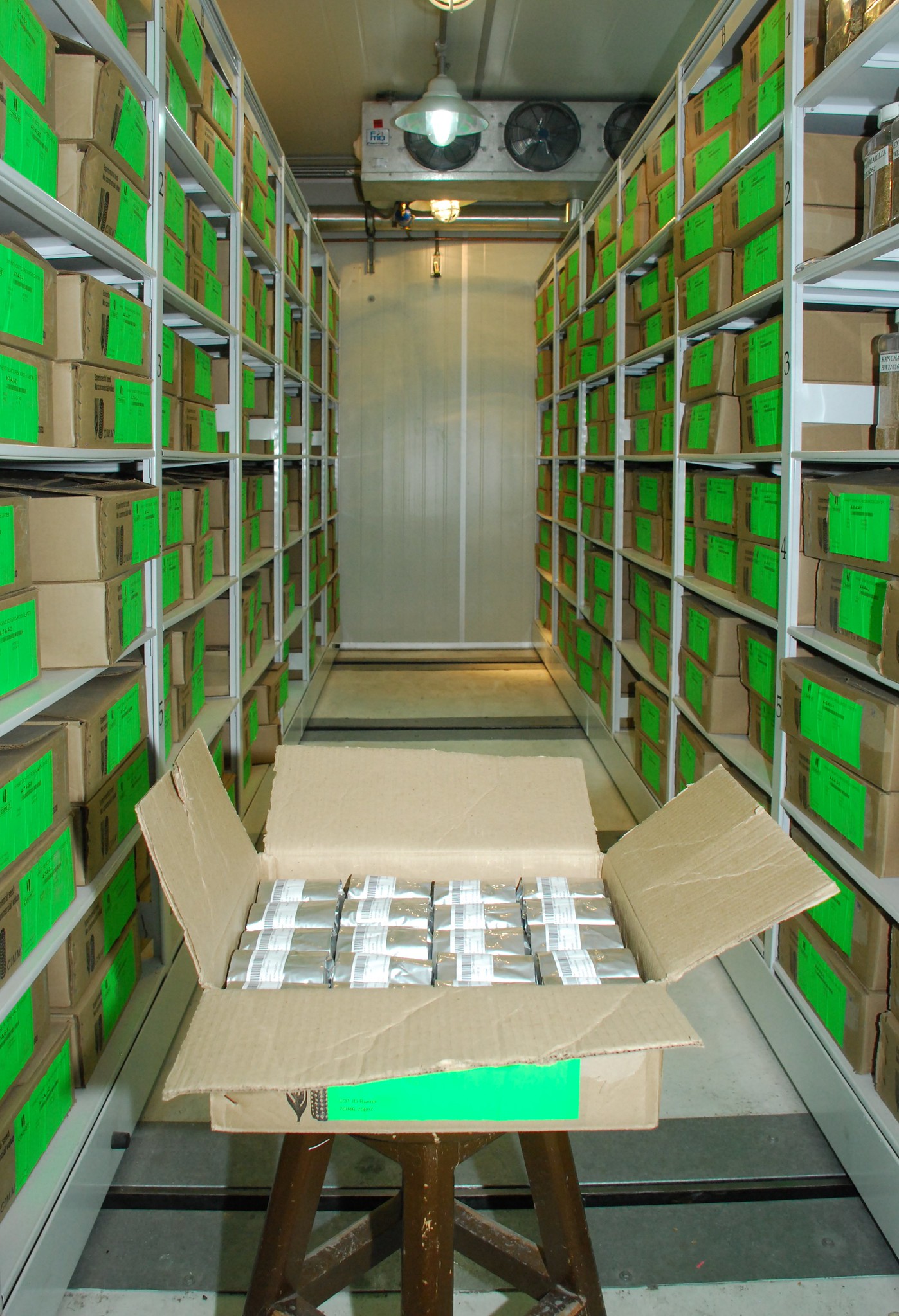
There are many vital genebanks, with community, national, regional, and international affiliations. Harmonization of these efforts into a global conservation network is needed. In wheat, for example, we do not adequately understand the diversity of the crop’s wild relatives. A recent study from Kansas State University observed that two thirds of the accessions of Aegilops tauschii held by several key collections were duplicates. This is an alarm to the global wheat community. The ex-situ collection of a critical species is less representative and more vulnerable than the sheer number of accessions would imply. We need to conduct a thorough characterization of all crop wild relatives to assess the risks to diversity, and a gap analysis of newly collected materials to ensure that their long-term conservation adds unique diversity to existing collections.
Which of the Triticum species that you store in the CIMMYT wheat genebank should, in your opinion, be explored much more?
Species that can readily cross with cultivated wheat, both bread wheat and durum wheat, should have intensified conservation and characterization efforts. Examples of these include Triticum monococcum subspecies monococcum (Einkorn) and Triticum turgidum subspecies dicoccon (Emmer).
What were the most surprising results from the genetic diversity analyses of nearly 80,000 wheat accessions from the CIMMYT genebank?
Modern, molecular genetic tools confirmed, for the most part, the centuries-old Linnaean taxonomic classification of Triticum and Aegilops species. There are generally two broad schools of taxonomists, “lumpers” and “splitters.” The former groups species based on a few common characteristics, and the latter defines multiple taxa based on many traits. The Seeds of Discovery work, in partnership with Michiel van Slageren from Kew Gardens, is confirming the salient taxonomy of the Triticum genus. Van Slageren previously studied and published a taxonomic monograph on the wheat ancestral Aegilops genus.
How can a genebank managers help in pre-breeding?
Maintaining native genetic diversity for use in the future is an important role that genebank managers play in pre-breeding and applied breeding processes. Furthermore, the identification of rare and odd variation plays an important role in understanding trait expression. Genebank managers are now gaining a stronger understanding of the genetic representativeness of their collections, and they can identify where gaps in the conserved genetic diversity may exist. A better understanding of the collections will enable their sustainable conservation and use.
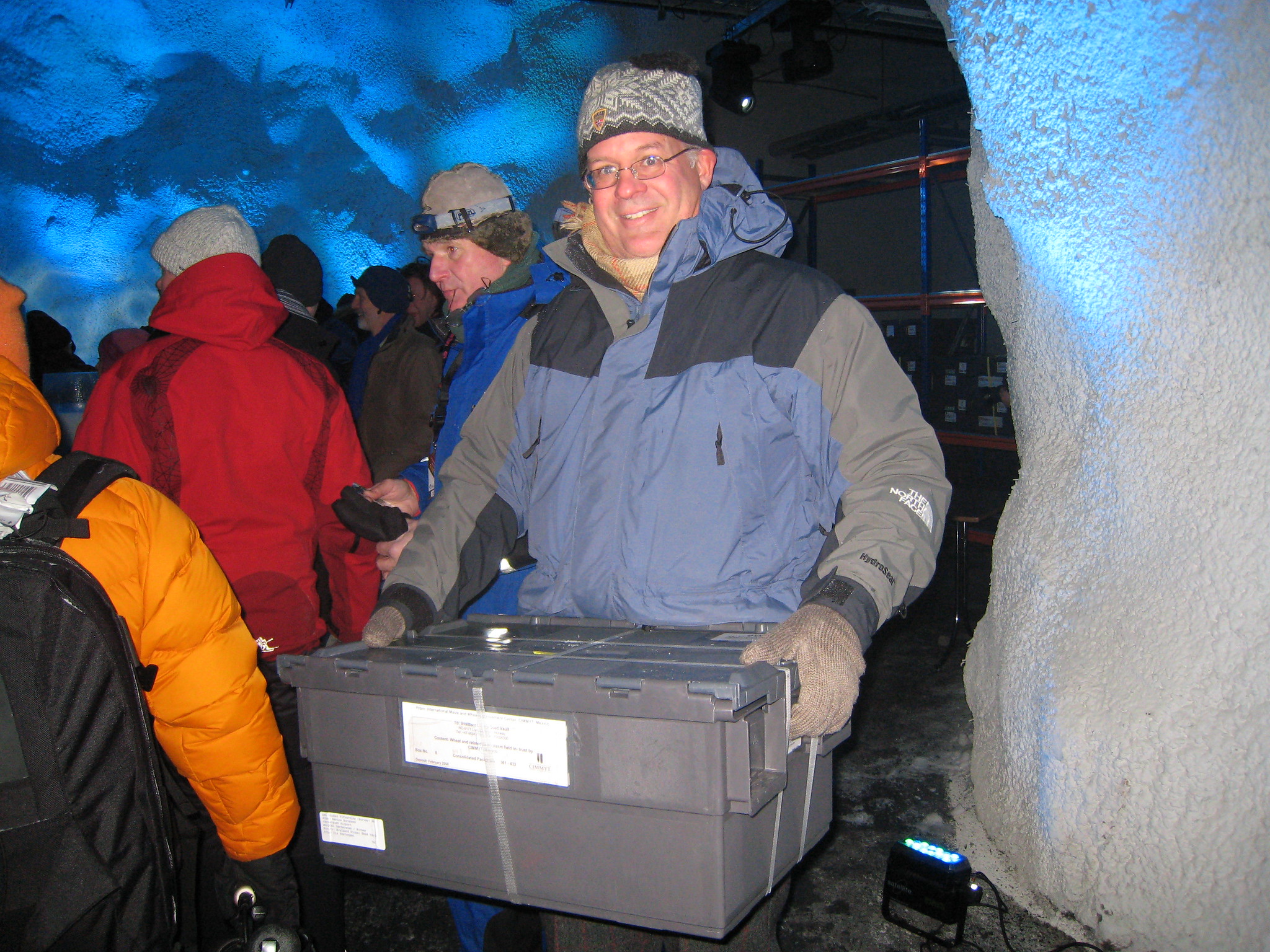
What would you consider the biggest challenge when striving for genetic diversity in breeding wheat for the future?
CIMMYT and other CGIAR Centers are rightfully proud of their stewardship of global public goods, and the free access to and distribution of germplasm and information. Yet outside of the CGIAR, the two-way sharing of germplasm and knowledge is often still not realized by many crop communities. International agreements have attempted to bridge recognition of intellectual property rights with guaranteed access and benefit-sharing mechanisms. However, the playing field remains uneven between public and private organizations due to varied levels of investment and exclusivity, access to technology and information, and marketability.
What is one way we can ensure long-term conservation of staple crops around the world?
In the past few years, several internationally renowned germplasm collections have been destroyed due to civil conflicts, natural disasters and fires — for example in Aleppo, Cape Town and Sao Paulo. Each time, we hear what a shame it was that the destroyed heritage was lost, that it was irreplaceable and beyond value. When a genebank loses an accession, the ancestral lineage extending hundreds of generations becomes permanently extinct. Genebank managers recognize this threat, and hence duplicate samples of all accessions are now slowly being sent to the Global Seed Vault in Svalbard for long-term preservation.
Cover photo: Tom Payne, Wheat Germplasm Collections & International Wheat Improvement Network Manager. (Photo: X. Fonseca/CIMMYT)
The many colors of maize, the material of life
Tonahuixtla, a small town located in Mexico’s state of Puebla, had suffered extreme environmental degradation due to deforestation and erosion. Agricultural land was in poor condition and the town had stopped producing many of their heirloom maize varieties, a loss to both biodiversity in the region and local culture. Poverty had increased, forcing many to migrate to bigger cities or to the United States for work. Those who were left behind, most of them women, had few ways to generate income to support their families.
Today, the story of Tonahuixtla is different. The town actively participates in reforestation and erosion-prevention activities. Landrace maize production is increasing, preserving the town and region’s biodiversity and customs. The residents have job opportunities that allow them to stay in their town and not migrate, all while preserving local biodiversity and protecting the environment.
What caused this change?
Corn husks.
Long considered a waste product, corn husks have been given a new lease on life through the Totomoxtle project. Named for the traditional indigenous Nahuatl word for corn husk, Totomoxtle turns the husks of native maize, found in a variety of colors, into a beautiful and sustainable veneer for furniture and walls. Founded by Mexican graphic designer Fernando Laposse, Totomoxtle has given farmers an incentive to plant native maize again, preserving invaluable biodiversity for future generations.
When Denise Costich, head of the maize collection of the germplasm bank at the International Maize and Wheat Improvement Center (CIMMYT), heard about the Totomoxtle project she knew she wanted to help. Passionate about preserving native maize, she and her team identified 16 landrace varieties from the CIMMYT maize collection that would produce husks in interesting colors and could grow well in the altitude and climate conditions of Tonahuixtla. She invited Laposse and project members to come visit the genebank and learn about CIMMYT’s work, and provided them with seed of the landraces they had identified.
“This is what we normally do in our work at the germplasm bank, we give people seed,” Costich said. “But this turned into a closer collaboration.”

Colorful collaboration
The maize germplasm bank team arranged for Totomoxtle project members to receive training in how to make controlled pollinations in the native maize varieties, at one of CIMMYT’s experimental stations.
“The technicians at CIMMYT’s Agua Fria station loved meeting the project members from Tonahuixtla, and immediately became passionate about the Totomoxtle project,” Costich said. “To this day, the technicians still save all of the colored corn husks from CIMMYT maize trials and send them to Tonahuixtla to provide them with additional material for their project.”
In the village of Tonahuixtla, project members — many of them women — work to iron the corn husks flat and glue them on to a stiff backing, then send them via courier to Laposse’s workshop in London where he uses them to create beautiful furniture and wall panels. This work allows the residents of Tonahuixtla to stay in their village and not be forced to migrate, all while preserving maize biodiversity and protecting the environment.
“Part of what this project is doing is also helping to keep families together — providing livelihoods so that people can stay in their communities, so that they don’t have to send all of their young people off to Mexico City or to the United States. To me, it’s really all connected,” Costich said.
The value of sustainability
The project also shows the intersection between biodiversity conservation and protecting the local environment. The maize husks used for the project are a sustainable and biodegradable material, and any residue from the maize husks that are not used for the Totomoxtle project are either fed to animals in the dry season or used to make fertilizer, which is then returned to the maize fields, a completely circular cycle in which nothing is wasted.
“I think that many of the communities that we work in really do understand the value and the importance of biodiversity,” Costich said. “In Tonahuixtla, the people are trying to reforest the hillsides in their region. They understand the connection between having no vegetation on the hills and having the rain water just roll right off the hills and into the temporary streams, thus losing that critically important resource. Over the years, as a result of the work they have done there, they have seen with their own eyes the improvement in the environment, not only that the hills are now covered with vegetation, but also they see a lot less runoff and erosion. I think that’s a really important lesson for everyone. I come from an ecology background, so I am always very excited to get involved in projects where it’s not just about maize, it’s about everything. It’s also about people’s lives, and nutrition, and the connections between them.”
Preserving local maize biodiversity is not just important for Tonahuixtla — it is important to all of humanity. Native maize varieties have adapted for thousands of years in farmers’ fields across Mesoamerica, developing natural resistance to local plant pests and diseases, as well as climatic conditions such as heat or drought. These native maize seeds, passed down generation to generation, could hold the key to developing improved maize varieties that can resist emerging maize diseases or extreme weather events related to climate change. If this biodiversity is lost, it represents a loss to global food security as a whole.
CIMMYT works to protect many of these native maize varieties in their germplasm bank, which is home to over 28,000 different collections of maize. Kept in cold storage under optimum conditions in the CIMMYT seed vault, these seeds are preserved for future generations and are available to anyone who needs them, including farmers such as those in Tonahuixtla, who had lost much of their native maize diversity.
“The biodiversity of cultivated plants is basically the guarantee for the future,” Costich said. “This is our security backup. Seed security is food security.”
Cover photo: Denise Costich (center, pink hat) stands with members of the Totomoxtle project and CIMMYT Germplasm Bank staff members near Tonahuixtla. (Photo: Provided by Denise Costich/CIMMYT)
Preserving the legacy of biodiversity
Seed security is the first step towards food security. The International Maize and Wheat Improvement Center (CIMMYT) preserves 28,000 unique seed samples of maize and 150,000 of wheat at its genebank in Mexico.
The Global Seed Vault in Svalbard opened in 2008. Since then, CIMMYT has duplicated and deposited 50 million seeds — 170,000 samples of maize and wheat — at Svalbard.
This year, CIMMYT sent 24 boxes of seed, with 332 samples of maize and 15,231 samples of wheat.
Join these seeds on a journey, as they travel more than 8,000 km from CIMMYT’s genebank in Mexico to the Global Seed Vault in the Arctic.
A supermarket, rather than a museum
This treasure, kept in the global network of genebanks, is key to ensuring sustainable, nutritious agricultural systems for future generations.
The purpose of genebanks is not just to preserve seed, but to use its biodiversity to address the needs of the future — and the needs of today.
Climate change is already impacting resource-poor farmers and consumers in low- and middle-income countries. Researchers and breeders at CIMMYT are rolling out solutions to these challenges, based on the diverse genetic resources kept in the genebank. As a result, farmers can use new varieties that yield more, need less inputs, and are more tolerant to drought or heat.
Our internal estimates show that about 30% of maize and more than 50% of wheat grown worldwide can be traced to CIMMYT germplasm.
Humanity’s legacy
Maize and wheat originated about 10,000 years ago. Since then, it’s survived war, drought, diseases, migration, birds, low yields — and the hard choice between feeding children or planting again.
Keepers of genebanks around the world are only the depositors of this legacy, which belongs to all humanity. CIMMYT will continue to preserve these seeds and to make their biodiversity available to researchers and famers, to solve today’s and tomorrow’s most pressing issues.
Cover photo: A NordGen staff member brings a box of seed into the Global Seed Vault in Svalbard, Norway. (Photo: Thomas Sonne/Common Ground Media for NordGen)
Bringing landraces back home, 50 years later
Maize is more than a crop in Mexico. In many cases, it connects families with their past. Landraces are maize varieties that have been cultivated and subjected to selection by farmers for generations, retaining a distinct identity and lacking formal crop improvement. They provide the basis of Mexico’s maize diversity.
Back in 1966-67, researcher Ángel Kato from the International Maize and Wheat Improvement Center (CIMMYT) collected 93 maize landraces samples from 66 families in Mexico’s state of Morelos. These seeds were safeguarded in CIMMYT’s Germplasm Bank, which today stores 28,000 samples of maize and its wild relatives from 88 countries.
50 years later, doctoral candidate Denisse McLean-Rodriguez, from the Sant’Anna School of Advanced Studies in Italy, and researchers from CIMMYT started a new study to trace the conservation and abandonment of maize landraces over the years.
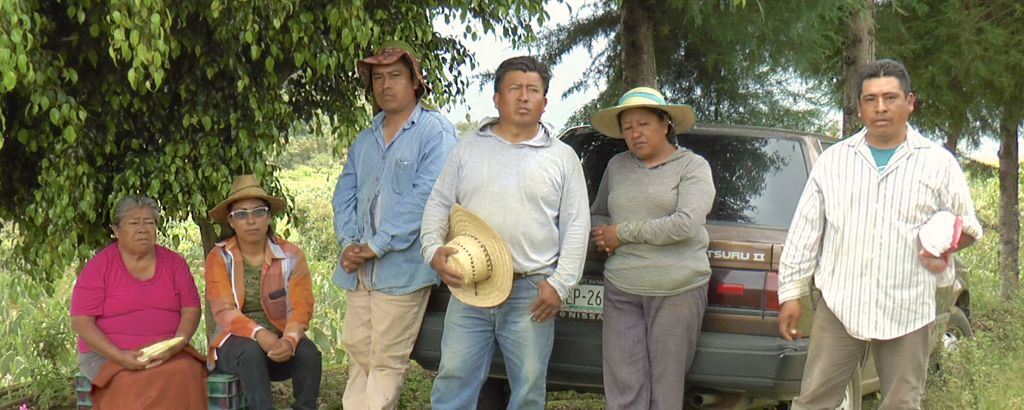 The study shows that landrace abandonment is common when farming passes from one generation to the next. Older farmers were attached to their landraces and continued cultivating them, even in the face of pressing reasons to change or replace them. When the younger generations take over farm management, these landraces are often abandoned. Nonetheless, young farmers still value the cultural importance of landraces.
The study shows that landrace abandonment is common when farming passes from one generation to the next. Older farmers were attached to their landraces and continued cultivating them, even in the face of pressing reasons to change or replace them. When the younger generations take over farm management, these landraces are often abandoned. Nonetheless, young farmers still value the cultural importance of landraces.
Maize landraces can be conserved “in situ” in farmers’ fields and “ex situ” in a protected space such as a germplasm bank or community seed bank. The loss of landraces in farmers’ fields over 50 years emphasizes the importance of ex situ conservation. Traits found in landraces can be incorporated into new varieties to address some of the world’s most pressing agriculture challenges like changing climates, emerging pests and disease, and malnutrition.
This research was supported by the CGIAR Research Program on Maize (MAIZE), the Sant’Anna School of Advanced Studies, Wageningen University and the Global Crop Diversity Trust.
Researchers are hunting for the “climate gene” that can save food plants
If plants are to adapt to a harsher climate, they must have genes that tolerate stress. Read more here.
Seed savers celebrate “Doomsday Vault” tenth anniversary
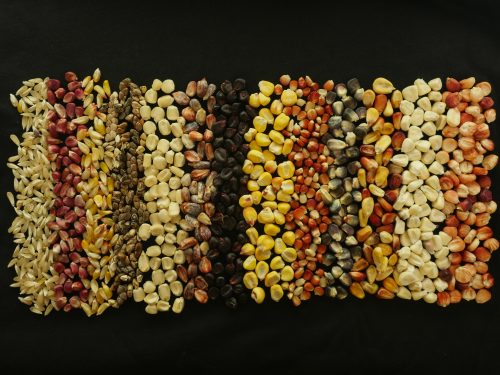
EL BATAN, Mexico (CIMMYT) — The “Doomsday Vault,” that safeguards fall-back collections of key food crop seeds in the arctic cold of Longyearbyen, Norway, marks its tenth anniversary this year. To celebrate, leaders in the conservation of crop genetic resources are gathering next week to discuss best practices and to encourage sustainable use of the resources.
The Svalbard Global Seed Vault sits 1,300 kilometers north of the Arctic Circle; the farthest north commercial flights will take you. It is described as the world’s largest secure seed storage and was established by the Norwegian Government in February 2008. Repurposing an abandoned coal mine, the global seed vault is set deep into the natural permafrost of the Norwegian island of Svalbard.
Over the last decade, seed-preserving institutions worldwide have shipped backup collections of seed and other plant parts for storage in the vault, which now holds nearly 900,000 varieties of essential crops, representing over 4,000 plant species, which could be drawn upon to restart agriculture in case of a catastrophe.
The International Maize and Wheat Improvement Center (CIMMYT) is the top contributor to the vault, with over 150,000 unique collections containing a total of nearly 50 million seeds and representing roughly 85 percent of the entire CIMMYT germplasm bank collection.
The target is to have 90 percent of the CIMMYT entire collection backed up at Svalbard within two years, according to Thomas Payne, head of CIMMYT’s Wheat Germplasm Bank, which is located in Mexico. CIMMYT’s Maize Germplasm Bank, led by Denise Costich, has already reached that goal.
“We send seeds every other year, accumulating packets until we have a critical mass and sending them in a large, single shipment,” Payne said.
Preparing and shipping the seed involves intricate coordination and painstaking work. For starters, seed must be sent in the winter to avoid it sitting on hot airport tarmacs. Additionally, the Svalbard vault opens for new deposits only a few times a year, so shipping logistics need to match up those dates.
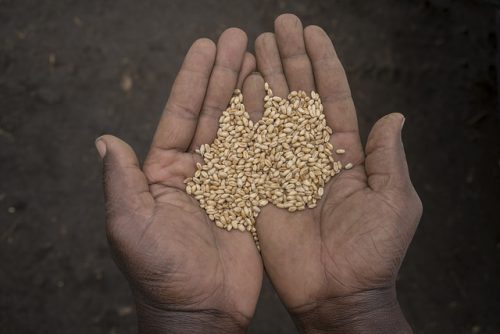
Only seed of the highest quality is sent to Svalbard, in part to ensure that the stored seed retains as long as possible its ability to germinate.
CIMMYT Germplasm Bank seed collections are regularly tested for germination capacity by placing a batch of seeds in a wet paper towel for 7-10 days. When less than 85 percent of a unique collection is viable, then the entire collection is replaced with fresh seed grown from the viable portion.
“There are seed collections at CIMMYT that still meet the minimum viability standard after more than 50 years under storage,” Payne said, noting that the center’s long-term collections are kept at minus 18 degrees Centigrade and in low humidity.
Payne said the center keeps duplicate collections in Mexico of all the seed it sends to Svalbard and monitors those Mexico back-ups to keep tabs on the viability of its Svalbard deposits.
Payne explained “To check seed viability, we have to take seeds out of storage, representing a loss of several hundred seeds. It’s almost a self-defeating process, balancing viability testing with sufficient quantities of seed to test and distribute.”
Payne said scientists are seeking new, non-invasive ways to test seed viability, potentially by checking seed respiration rates or rapid germination imaging technologies.
The government of Norway and the Global Crop Diversity Trust cover the cost of storage and upkeep of the Svalbard Global Seed Vault, coordinating shipments in conjunction with the Nordic Genetic Resource Center. Established in 2006, the Crop Trust supports the conservation and availability of crop diversity for food security worldwide and helps to fund CIMMYT’s work to collect and conserve maize and wheat genetic resources. The CGIAR Genebank Platform also supports CIMMYT’s maize and wheat germplasm bank.
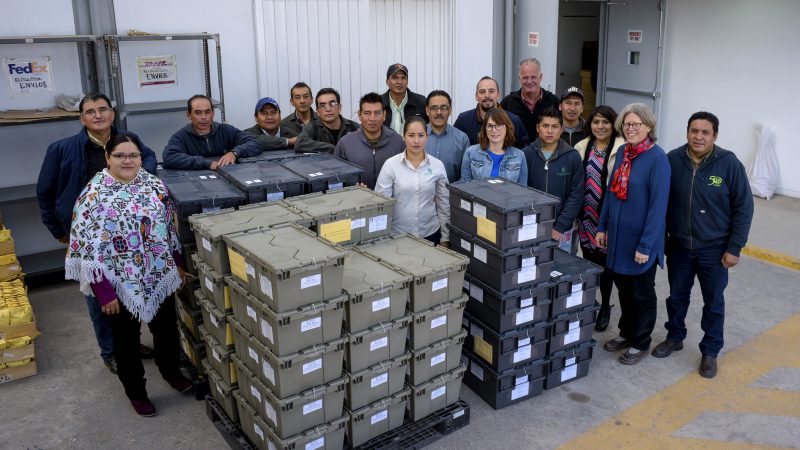
Learn more about the activities of the Maize Germplasm Bank here, and about the Wheat Germplasm Bank here.
The Maize and Wheat Germplasm banks at the International Maize and Wheat Improvement Center are funded by Global Crop Diversity Trust, the CGIAR Genebank Platform and Germany’s development agency.
